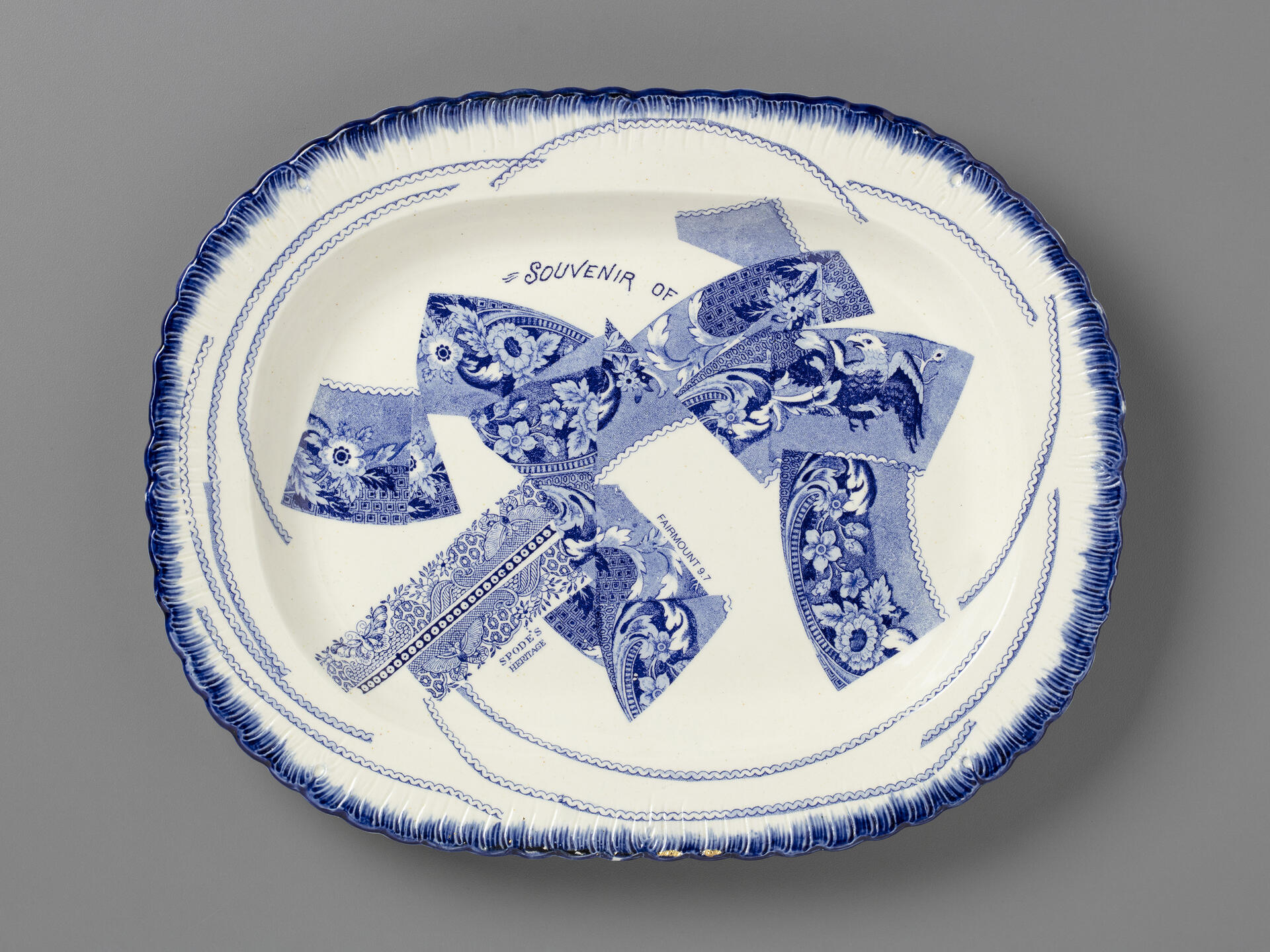
Paul Scott makes new prints and practices selective erasure, collage, breakage, and re-assemblage as he alters historic tablewares to depict the contemporary landscape. His New American Scenery installation juxtaposes these new works with Staffordshire ceramic transferwares representing sanitized, bucolic landscapes of the United States—tablewares that were enthusiastically acquired by American consumers in the nineteenth and early twentieth centuries. Using documentary and archival research as well as extensive travels (funded by The Alturas Foundation and Arts Council England), Scott employs the visual vocabulary and processes of historical transferwares in a new body of artwork. This work examines industrial dereliction, the politics of borders, physical manifestations of climate change, and energy generation and consumption, as well as the ongoing legacies of invasion, slavery, and racism.
The physical, mental, and artistic journeys that shaped this project are presented here in a text developed from a series of conversations. The recordings centered on the meeting of Scott’s new work with objects from the RISD Museum collection. These include the museum’s Boston State House plate with Scott’s work featuring the Indian Point Nuclear Power Plant, historical representations of Native Americans with new pieces about uranium mining on Navajo land in Arizona and New Mexico, and the museum’s Cape Coast Castle platter by Enoch Wood & Sons with works that examine the ongoing legacies of slavery and racism.
Paul Scott sat down with RISD Museum curator Elizabeth Williams to discuss his work and the history of transferware.
The following text derives from three recorded conversations.
***
T
ransferware is industrially printed pottery, often in blue and white, the most familiar pattern is probably Blue Willow. Concocted in Staffordshire over two hundred years ago to imitate export painted Chinese porcelain, the design has been produced in about fifty countries around the world and is widely recognized.
RISD’s collection of transferware is really outstanding. For somebody interested in blue and white transferware, it's a wonderful collection. You’ve got large platters, plates, jugs and teapots with a fine cross-section of subject matters. You usually find American transferwares in archives or museum storage these days. The interesting thing is that in the early part of the twentieth century, early wares became extremely desirable objects. Key figures, industrialists, and influencers of public opinion were collectors with the result that by the mid-twentieth century a number of large transferware collections were donated to American art museums. Nowadays most of these are no longer on display.
But my belief is that they’re worth a second look. They’re beautiful objects in themselves. They represent a particular version of American history. I’m aware, particularly at the moment, that there are conflicting views of what America is, what it stands for, and I don’t think it’s untimely for these to be brought out of storage to be put back on display, but they need to be contextualized. In this case I am complementing them with new wares which update and expand their depictions.
Transferware is, and certainly was, functional. But one of the great things about printed ceramics is that they have multi purposes. Once you put a print on a ceramic form, you're putting it onto a “loaded” object. A plate can be eaten off, given as a gift. (In the past pictorial dinner services would be given as wedding presents.) Transferwares have long been hung on the wall as pictures and in many households, pictures on plates were used as a substitute for the (expensive) oil paintings of the wealthy. Over time, specific methodologies of alternative display were also developed, on kitchen dressers and in display cases. So whilst transferwares are technically functional, in the sense that they can be eaten from, their use is extended to the pictorial.
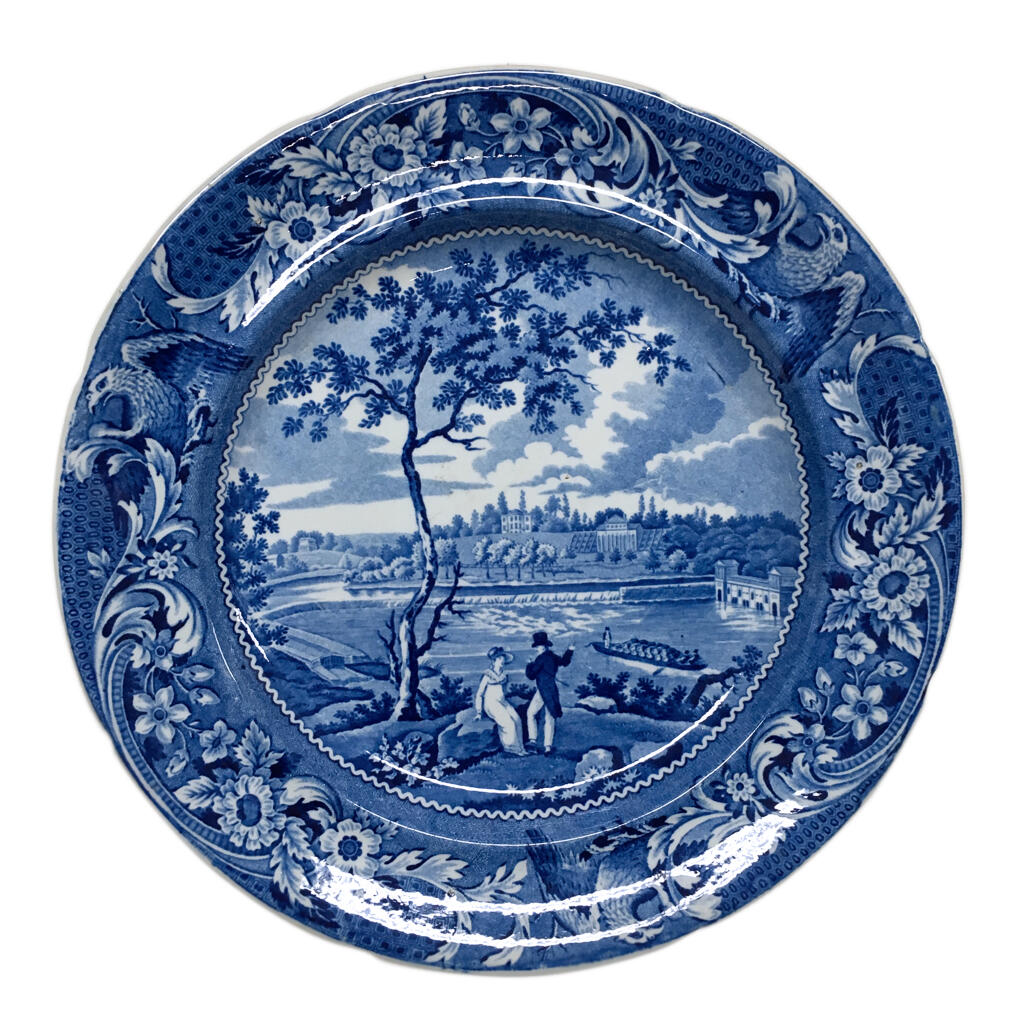

I
I work with historical transferwares, updating them for a contemporary audience. Over a number of years, I have been involved in research into early nineteenth-century printed Staffordshire ceramics—blue and white—and in particular, a whole genre of objects that were made specifically for American markets. These depict the early settled landscapes of the United States. More recently I have also been investigating the revival of the genre in the early twentieth century.
I make new works and update historical pieces. I interfere with antique wares. I erase, add, and recreate new “historical” patterns on blank ceramics. I work with screenprints, engraving, and collage.
Paul Scott inspects plates as they come out of the kiln at Project Art, Cummington, MA.
I became interested in transferware in the early ’90s. I’d written a practical handbook, Ceramics & Print, and it occurred to me that the work I was researching and featuring would make a great exhibition. So I worked with the late Terry Bennett at Tullie House Museum & Art Gallery in Carlisle, Cumbria, and curated an exhibition that examined the reasons behind the growth of ceramics and print in contemporary visual-art practice. As part of the show I created a printed blue and white plate of Sellafield, the nuclear reprocessing plant on the west coast of Cumbria, about forty miles from my home. It was based upon Spode’s Italian pattern, a classic transferware design depicting a confected Italianate pastoral landscape. In place of the romantic ruins and river, I inserted Sellafield and the road leading to the nuclear plant, collaged with distorted Willow and Delft details. In the border pattern I adapted the Spode design to include radioactive bugs, fishes, and radiation symbols. All this on a ready-made bone-china plate from a factory shop.
That was my piece for the show, and I think I made an edition of ten plates. Much to my amazement, as the exhibition toured, all the works in the series were sold. That’s a very good thing for an artist—you create something you enjoy making, that you’re happy with, and then you’re able to sell it. The experience of developing the work was fascinating. I enjoyed distorting and playing with the graphics, enlarging and reducing details, collaging then fitting the composite to this decorative form. (It’s an interesting discipline to have to fit image and pattern to a particular shape.)
People recognize a Blue Willow pattern plate, they know what it looks like. It’s part of the cultural wallpaper in their heads. So when people see a blue and white plate or a piece of transferware, they register that’s a familiar object. Then suddenly they realize there’s a nuclear power station in it, and that’s not what they expect to see.
I realized that I could do other things with this, so after the plate edition was sold out, I worked on a second piece. At the time I knew little about transferware but once I started digging, I discovered a genre of complexity and depth. I became inextricably drawn into the vast repository of pictorial and patterned material. The genre developed during the print (media) revolution of its time, so that pictures that were once the preserve of the wealthy became available to a mass population. Print created pictorial abundance on paper in books and magazines, but also reproduced in patterns on wallpapers, textiles, and ceramics. There were landscapes, portraits, abstracted patterns, text, and wares that were overtly political in nature. I discovered that as forms, these were familiar, that the related artworks I made connected with people in a way that prints on handmade objects hadn’t.
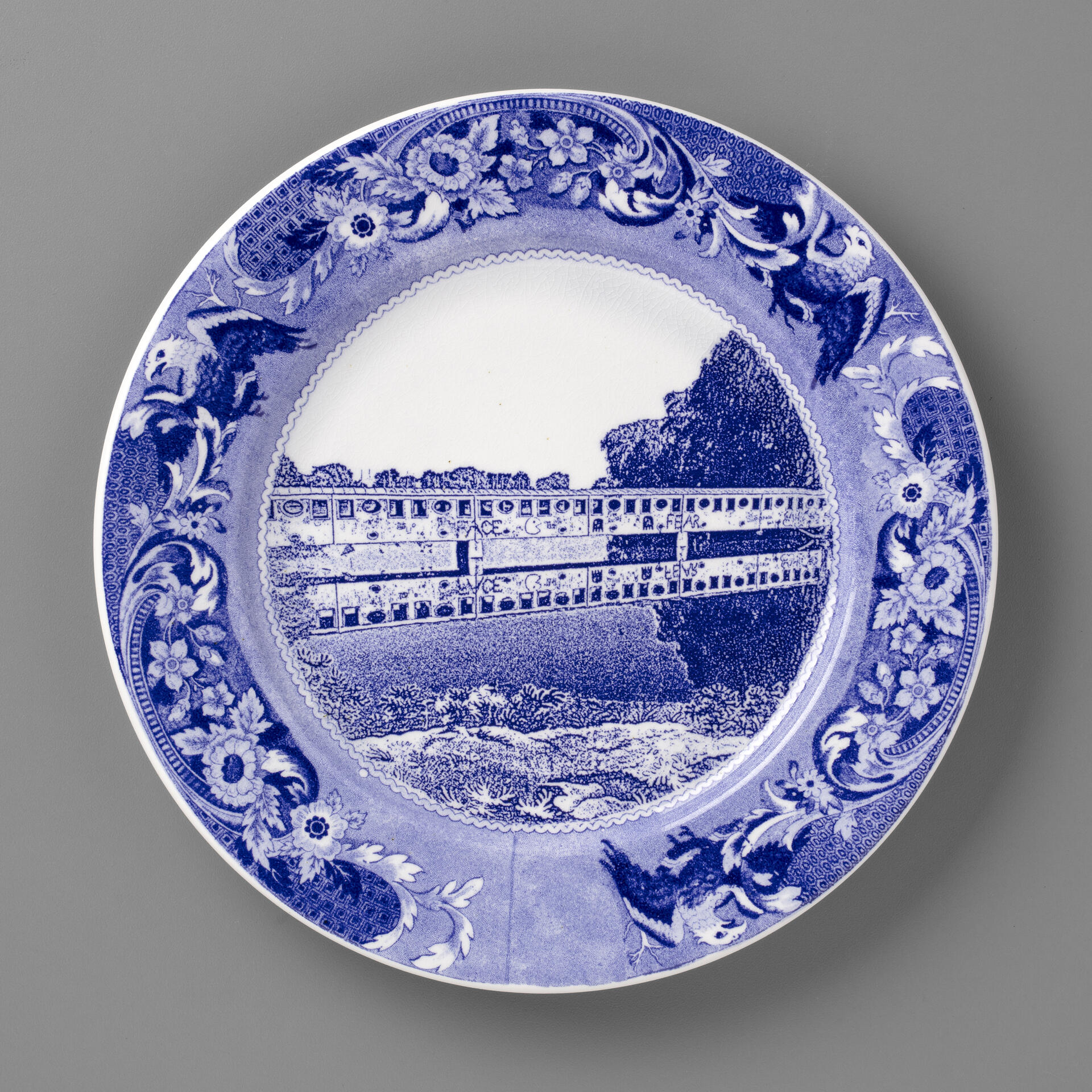
II
What I wanted to do was to depict America as I experienced it, rather than the sanitized versions that appear on transferwares.
N
ew American Scenery has its origins in a visit I made to the United States in 1999. I gave a lecture at Ohio State University, in Columbus, Ohio, for Mary Jo Bole, who was a professor at the time. They showed me the ceramic collection at the university, and to be honest, most of it left me cold, because I’m not the greatest fan of studio pottery and brown oatmeal pots. But hidden at the back of the cabinet, slightly obscured, was this blue and white plate. A platter by Enoch Wood & Sons, probably from around 1830, depicted a scene from the Hudson River. In the early nineteenth century, Staffordshire potteries exported pictorial wares of American landscapes to the United States. By this time I was familiar with British printed wares, but the surfaces of these objects were very different in character to the transferwares sold in England. I had never seen an object quite like this platter before. It was a deep, deep dark blue, with a great depth and subtlety in the imagery and this beautiful feel to it. Quite extraordinary, I’d never seen one for real before.
After the encounter, I began to investigate further. Initially I couldn’t find any of the wares in England, almost certainly because they were all created for export. In 2013 I had a residency at the Clay Studio in Philadelphia and used the time to visit a number of collections, including the Philadelphia Art Museum and Winterthur nearby. I found large quantities of this early nineteenth-century transferware, objects that pictured railways, penitentiaries, hospitals, libraries, canals, and lunatic asylums. In contrast the British wares I was familiar with, depicted idealized pastoral landscapes, chinoiserie, or scenes of the empire and hunting trips in India. So it was really extraordinary, and that’s where the notion of continuing the research, then producing a new body of work, began to take shape.
Whilst early transferwares were mainly of the Northeastern United States, with the revival of the genre in the early twentieth century, subject matters diversified to include places right across the country, including souvenirs of Texas, New Mexico, Arizona, California, etc. As I researched, it gradually dawned on me that these objects were depicting a particular view of America, one that was predominantly a white settler view of the country. Early transferwares, for example, had no American Indians featured at all. Black Americans were only to be found being loaded onto slaving ships. In the early twentieth century, Native Americans or American Indians are shown as the Hollywood variety of the “noble savage,” and situations were always positive for the white characters.
“Making tissue prints for transferware is like making clothes to fit a person”
“Transferware wasn't always cheap and cheerful”
I wanted to redress the balance a little bit. So whilst New American Scenery does include contemporary American landscapes based upon earlier city views, the work also features scenes with direct reference to Black America, and American Indians.
As a British artist I’m creating transferwares of American landscapes. Some might query the “visitor’s eye.”
I am, however, following a tradition, a long line of visitors to America who’ve written about and depicted the country. There was a Russian, Pavel P. Svin’in, who traveled in America as a secretary and translator, in the early nineteenth century. He subsequently wrote a book about his experiences illustrated by reproductions of the watercolor paintings he made during his travels. These illustrations were adapted by British pottery engravers and re-purposed as pictorial transferware designs, then subsequently exported to America. This Russian book was key in the process of spreading images of the United States to Europe. Eventually the remediated images returned on ceramics eventually to became part of Americana, part of American culture. Of the British pottery manufacturers, at least two of them, Adams and Stephenson, actually traveled around the United States themselves. Stephenson employed artists to paint selected views, then back in Staffordshire produced pictorial wares for export to the US.
Claire Leighton was an English engraver and illustrator who eventually made her home in America. As well as designing a set of plates for Wedgwood depicting ”New England Industries,“ she also wrote and illustrated books about her American experiences and impressions.
Another visitor was the Chinese artist Chiang Yee, who was exiled in London in 1933. He documented his early travels in Britain, illustrating his narratives in a characteristically Eastern style. His first book, The Silent Traveller: A Chinese Artist in Lakeland, was an immediate success on its first publication in 1937, selling out several reprints in a matter of months. As a travel author he became hugely popular for his fresh insights, observations, and illustrations. Later Yee also traveled to the United States writing and illustrating his Silent Traveller in Boston and another book about his time in New York.
So I’m following a tradition of artists traveling and depicting places that are not home. In my case I wanted to create a series of artworks that came from my experience of traveling in the United States and understanding contemporary issues affecting the American landscape. I’ve traveled here two or three times a year over the last five years, spending up to six weeks at a time. I’ve also been examining the way transferwares of the early nineteenth century were generated. Many landscape patterns were copied from magazines and books, their makers never actually leaving Staffordshire at all. Illustrations of the period (reproduced in the new media of the time) reflected mainly the Northeastern seaboard, and as a result most early transferware shows a particular narrow part of the United States.
New American Scenery references and updates the original transferwares made by British factories. Like Svin’in, Leighton, Yee, Adams, and Stephenson, my work is a personal response to being in and traveling in America. I’ve also used original source materials, engraved book illustrations and material from ceramic print archives, collaged with altered photographs harvested from today’s new media sources, Instagram and the web. Fleurs.de.sel’s New York series is a perfect exemplar of this process.
“Messing around with hierarchies: Scott on Warhol”
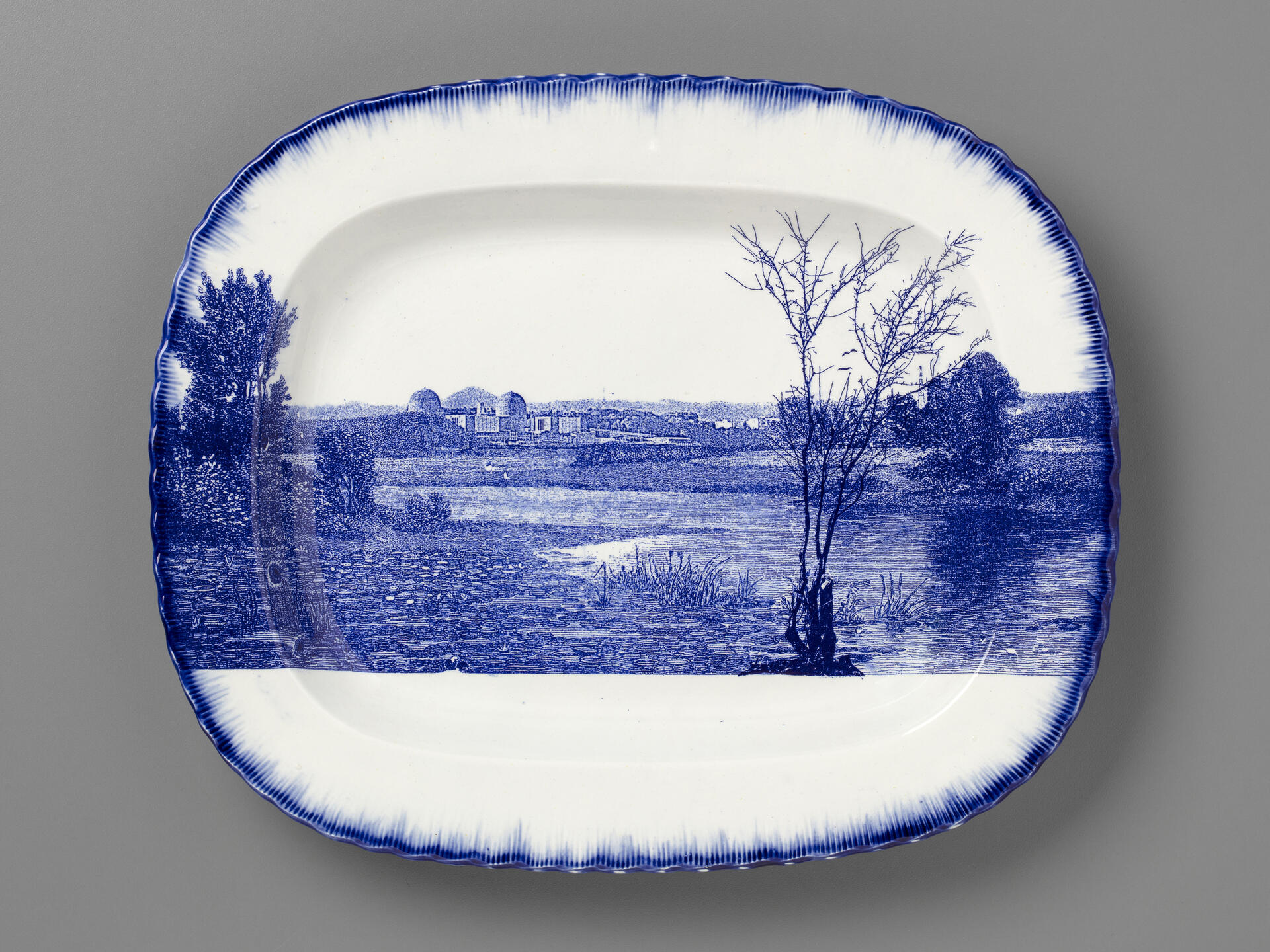
III
I
passed the Indian Point Nuclear Plant a number of years ago traveling on the Amtrak train going to New York. These huge industrial sites in the landscape have a perverse kind of majestic beauty for me. As I do, I photographed it, then later discovered that the plant is not without its controversies. During my residency at the Clay Studio in Philadelphia, I collaged my image of the plant together with details from old engravings, to re-create this pastoral landscape with Indian Point in the distance.
A few years later, when my friend Paul Holdway, the former head engraver at Spode, indicated to me that he would like to create an engraving of one of my images, this work came to mind, because it directly references those early nineteenth-century landscapes. It was a nice starting point. We agreed on a new pattern for a small cup plate pattern. I made a mock-up of the design I wanted him to engrave with a Wild Rose border around it, probably from the 1930s. He was not overly impressed with this detail, noting that the rose stems were coming from the “wrong edge,” and proposed an alternative Oak Leaf border that featured on a series of early nineteenth-century transferwares. He also suggested replacing my original cows with two based upon an early Boston State House design, and likened their architecture to the nuclear station’s domes.
It references those early nineteenth-century pastoral landscapes. They always had to have some cows. It was a nice starting point.
I found the process really interesting because certainly in the twentieth century, engravers given a new pattern to work on would then adapt the design and perfect it as part of their professional brief. In many ways they were artists/designers and as well as being consummate craftspeople. So partly because of my friend the copperplate engraver, we have the Indian Point Nuclear Power Station directly referencing a nineteenth-century transferware image of the Boston State House.
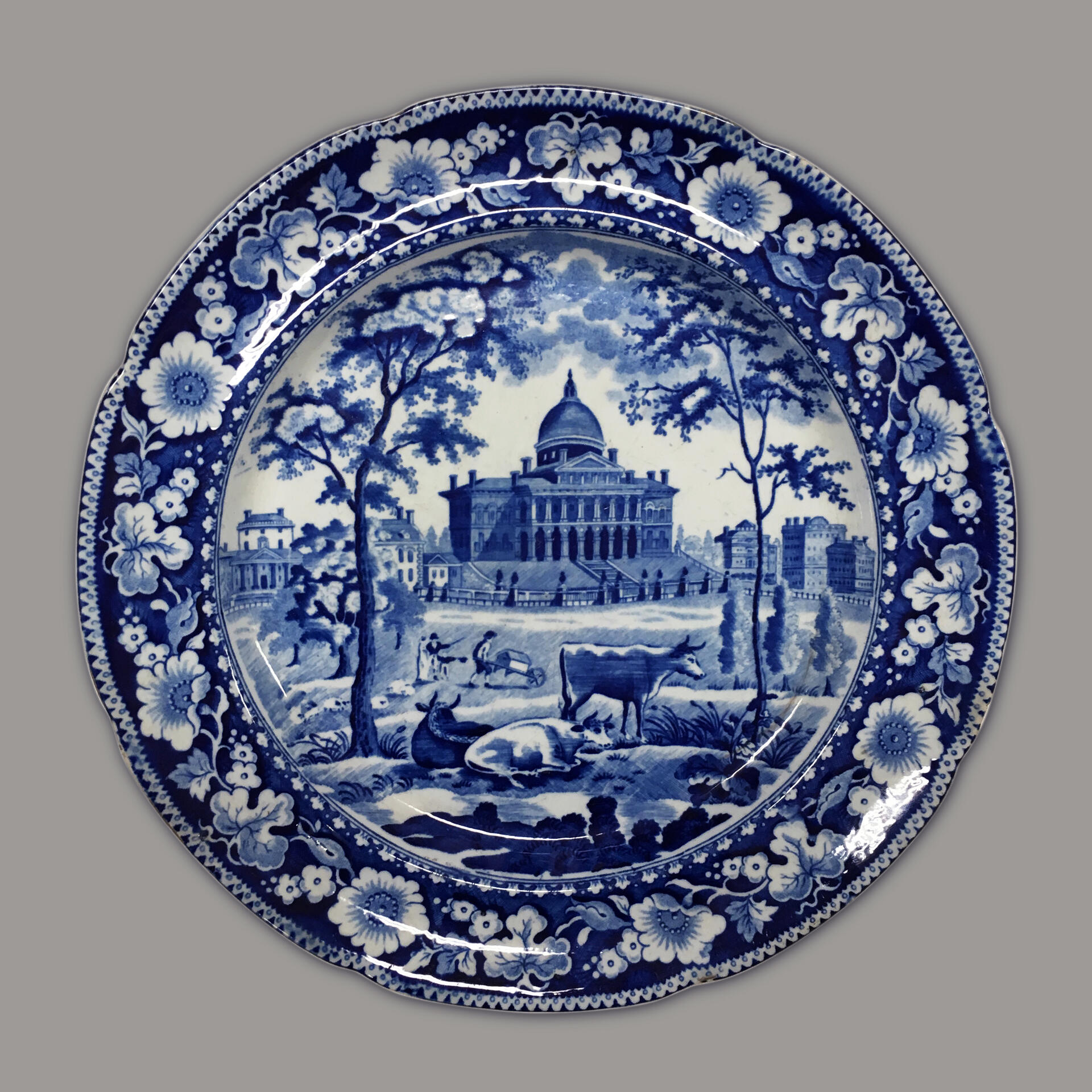
J. Rogers & Son, manufacturer | Boston State House (with Cows) Plate, ca. 1820 | RISD Museum 35.057
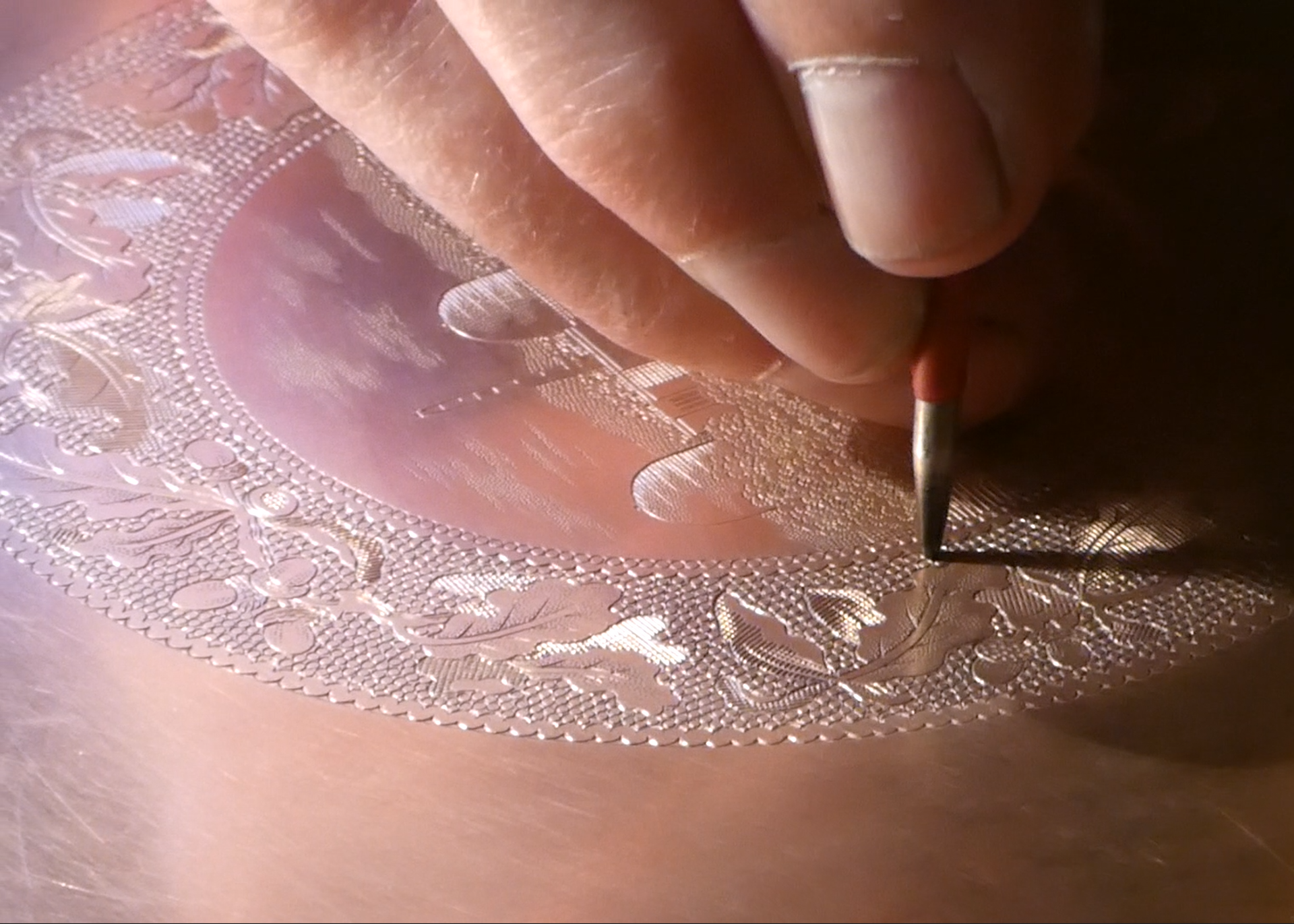
Paul Holdway engraves an oak leaf border into a copper plate. This plate was used to print the pottery tissue that gets applied to the Indian Point Cup Plate.

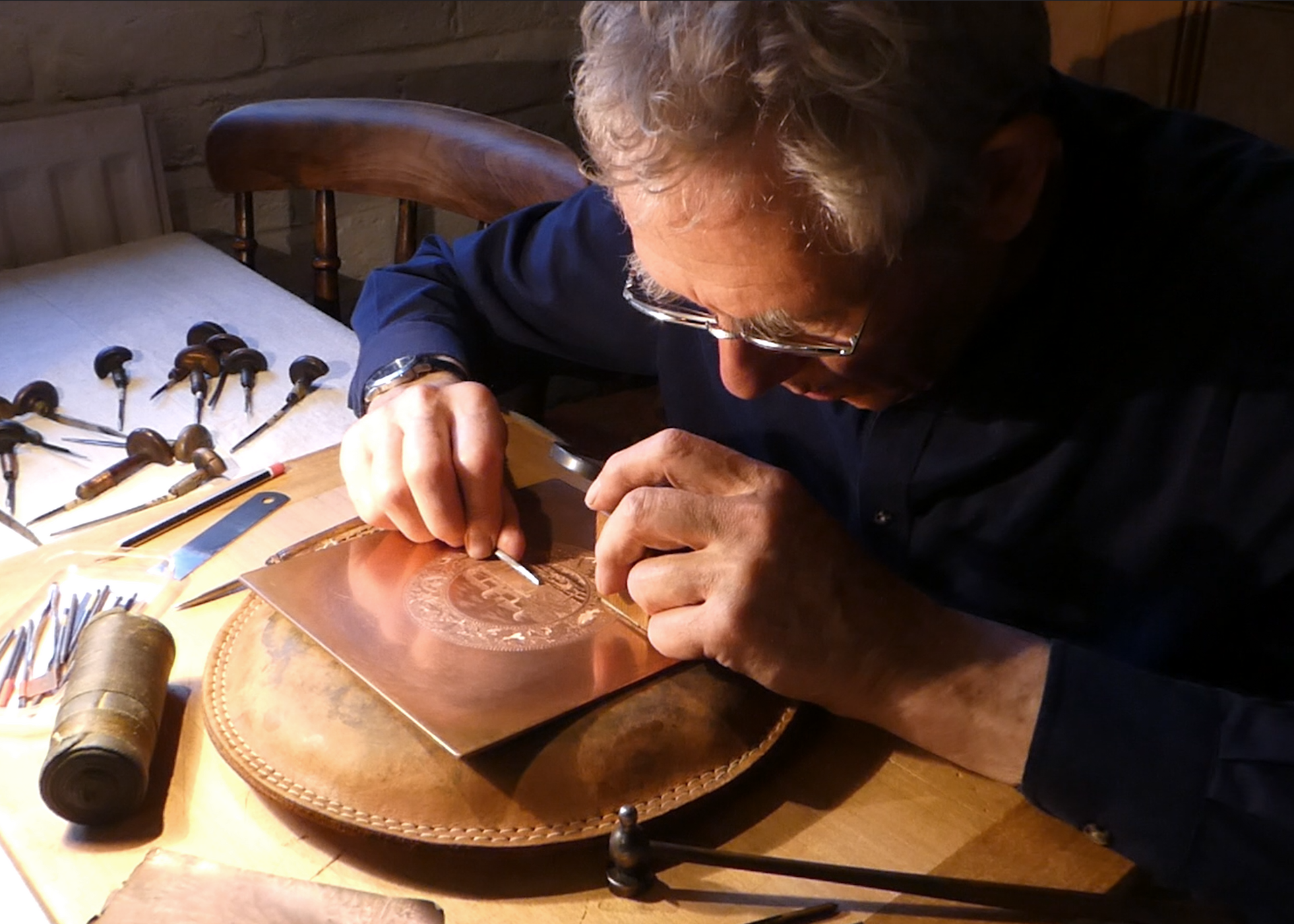
Paul Holdway with his engraving tools. Holdway was the Head of engraving at the Spode factory in Stoke before its closure in 2009.


Intaglio transfer print on pottery tissue, taken from the copper-plate engraving, next to a test plate.

The issue about the environment is one that is of course a relatively modern concern. You could argue that in the early nineteenth century, during the early stages of industrialization, humans were unaware of the long-term effects of some of the processes that were involved. But overwhelming evidence over the last sixty years means that there is no excuse today for declaring ignorance about the impacts of human activities on the planet. We now have incontrovertible scientific proof that human activity contributes massively to global warming through emissions of methane and carbon dioxide. In addition, through our insatiable greed for natural resources, love of plastic, as well as the indiscriminate use of herbicides and pesticides, we are now responsible for an accelerating wave of animal, bird, and insect extinctions that now threaten our very existence. Now, in the beginning of the twenty-first century, there is no excuse for denying the effects of industry on the environment.
Even in the early nineteenth century, there were voices voicing their alarm at what was happening. The painter Thomas Cole was concerned about the spread of industrialization. But in the twenty-first century, I find it remarkable and amazing that so many people seem to deny the dangers and the effect that the human race is having on the earth and its environment.
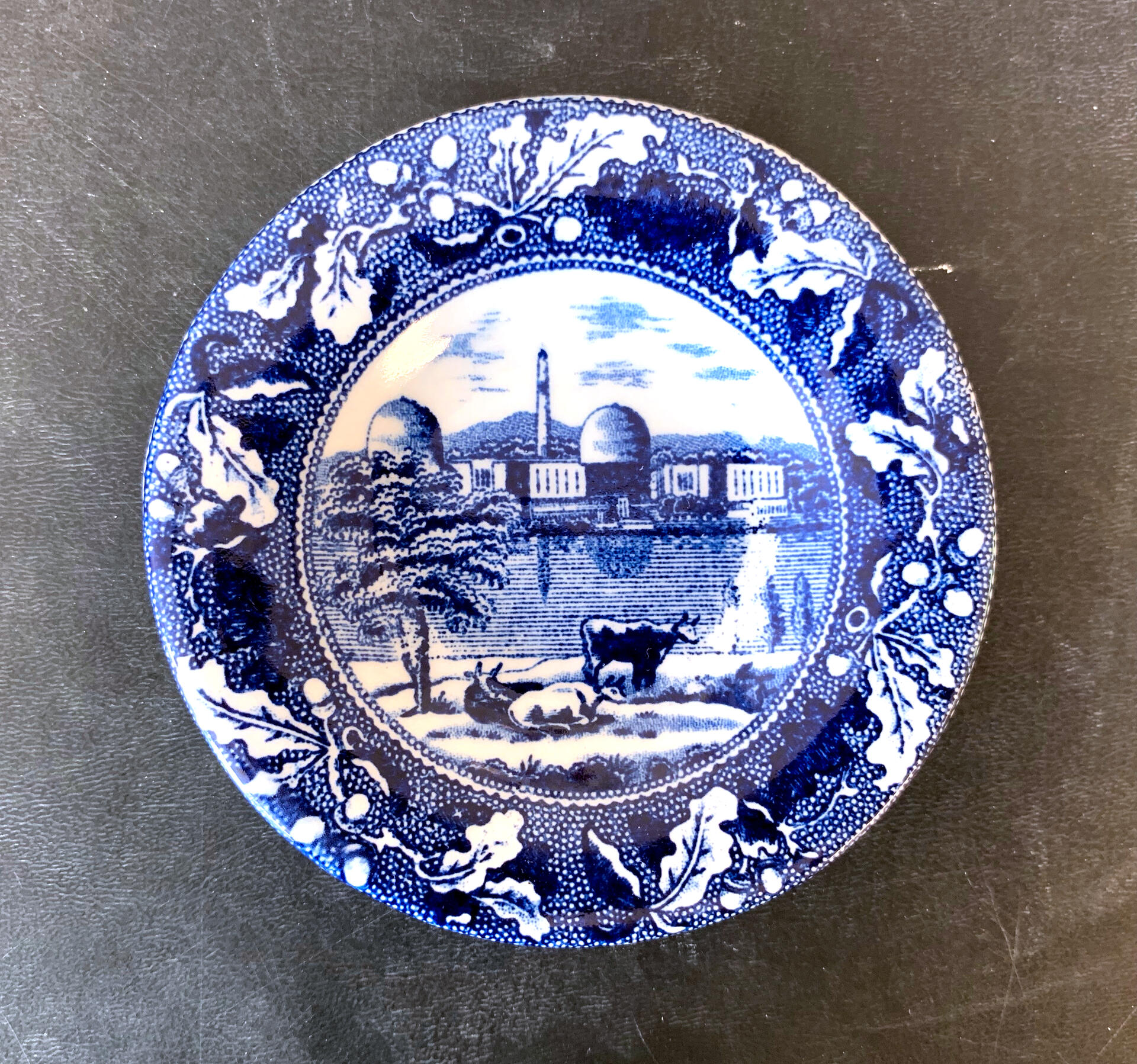
Paul Scott | Indian Point Cup Plate, 2019 | Transfer-printed earthenware
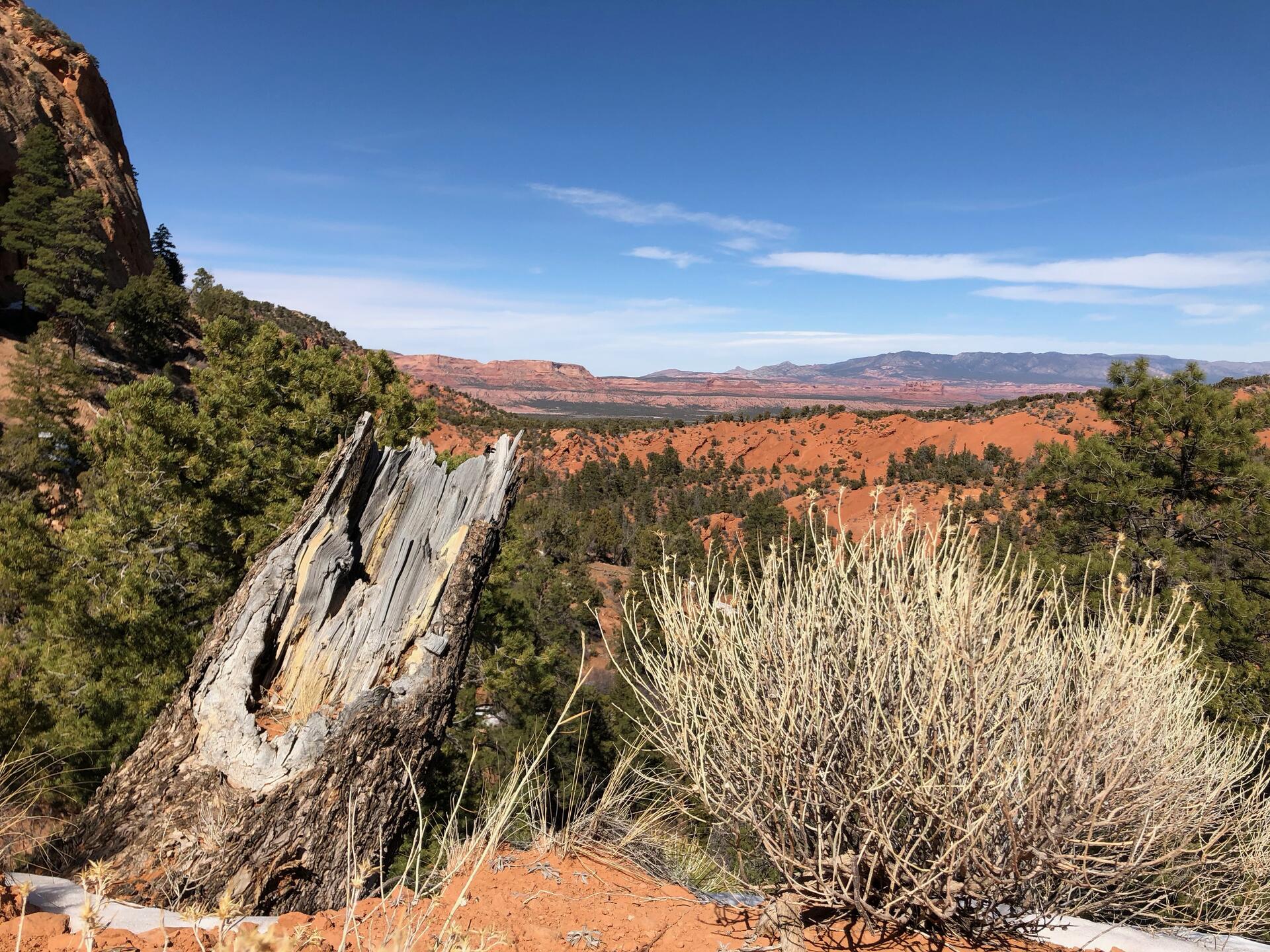
IV
The New American Scenery work that I’ve been doing has involved a number of personal journeys through the American landscape, but also journeys of discovery. Growing up in England, we consumed American culture in comics, books, and magazines and watched a lot of American TV series and films. I was very well aware of the Wild West, stories of cowboys and Indians, all that kind of stuff. The United States has been very good at projecting an image of itself across the world, of marketing its culture and the wonders of its continent. Perhaps that is why so many people have wanted to come to America.
When I was a student in my early twenties, however, I read a book that stopped me dead in my tracks and made me reassess everything that I’d known and been taught about American history. Dee Brown’s Bury My Heart at Wounded Knee documented the real stories of indigenous peoples during the settler move West. It documented massacres, forced relocations, and the attempted destruction of cultures, identities, and a way of life. It shocked me to my core. I remember it being such an important book, because it seemed that all that stuff that I’d learned about America was the wrong way around. It was one of those books that changed the whole way I saw the world. I began to question other histories I had been taught.
Nuclear energy, like atomic weapons, relies on uranium ore, and my research unearthed a book by Sarah Alisabeth Fox called Downwind: A People’s History of the Nuclear West. It was another one of those shocking moments, taking me back to Bury My Heart at Wounded Knee, except this wasn’t documenting events of a hundred fifty or two hundred years ago, this was just fifty years ago. This book documents the voices of people deeply affected by scandalous exploitation and an ongoing toxic legacy that still affects the people of the Navajo nation and the Southwest.
As part of my research, I decided that I would travel to northern Arizona and New Mexico to see for myself. Sarah Fox’s book contains testimonies and evidence from Navajo people, including a guy called Timothy Benally. I was looking for somewhere to stay in the Navajo nation and came across a bed and breakfast place in Cove run by a Karen and Timothy Benally. He turned out to be one and the same person. I was very fortunate to travel from Britain to New Mexico and then to northern Arizona to stay with the Benallys. For two days, I was privileged to be driven around Cove, Shiprock, in the Navajo nation whilst Timothy told me stories about his life and experiences working in the uranium mines.
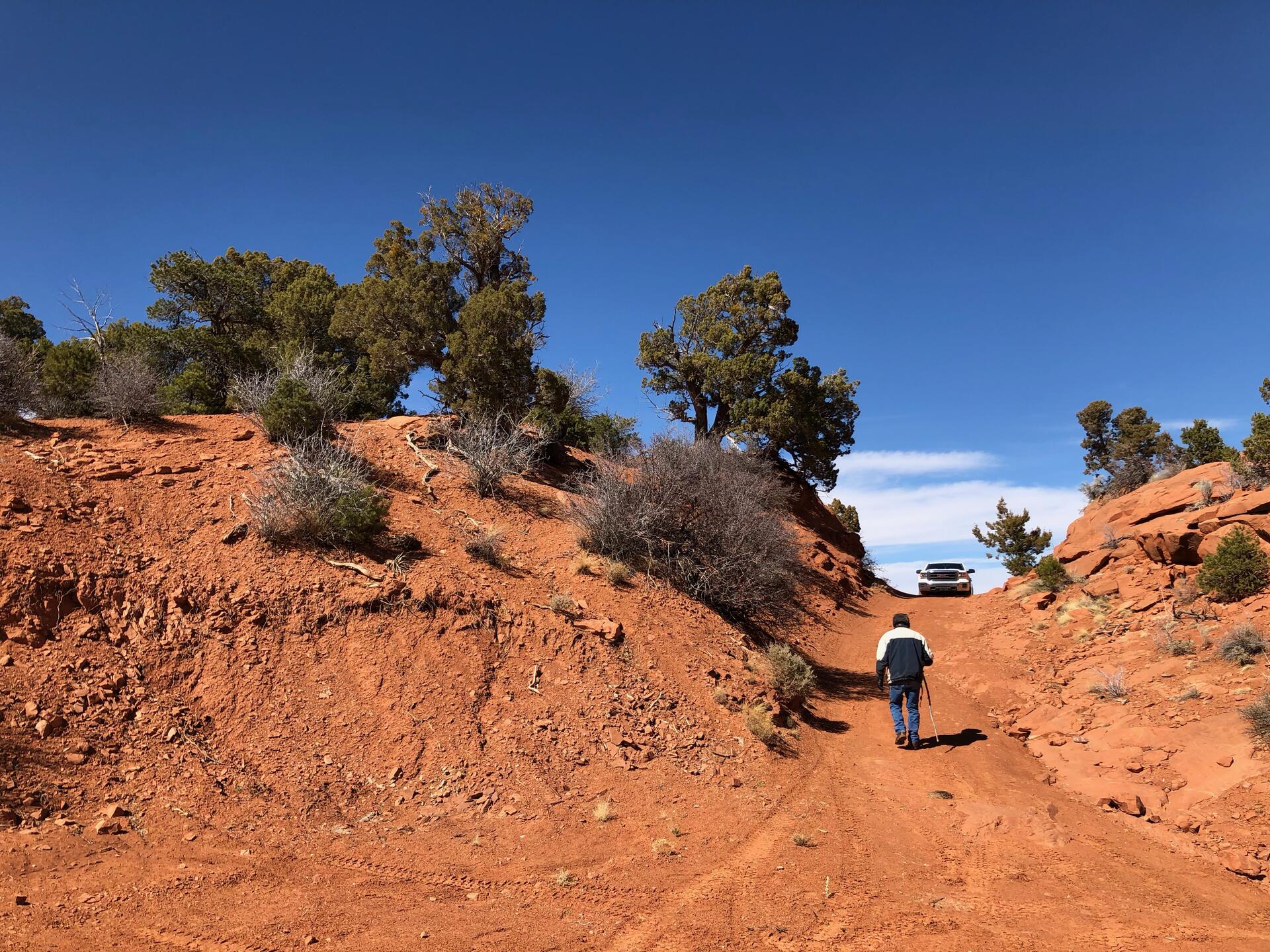
Timothy Benally walks up to his truck, in the landscape near Cove, AZ.

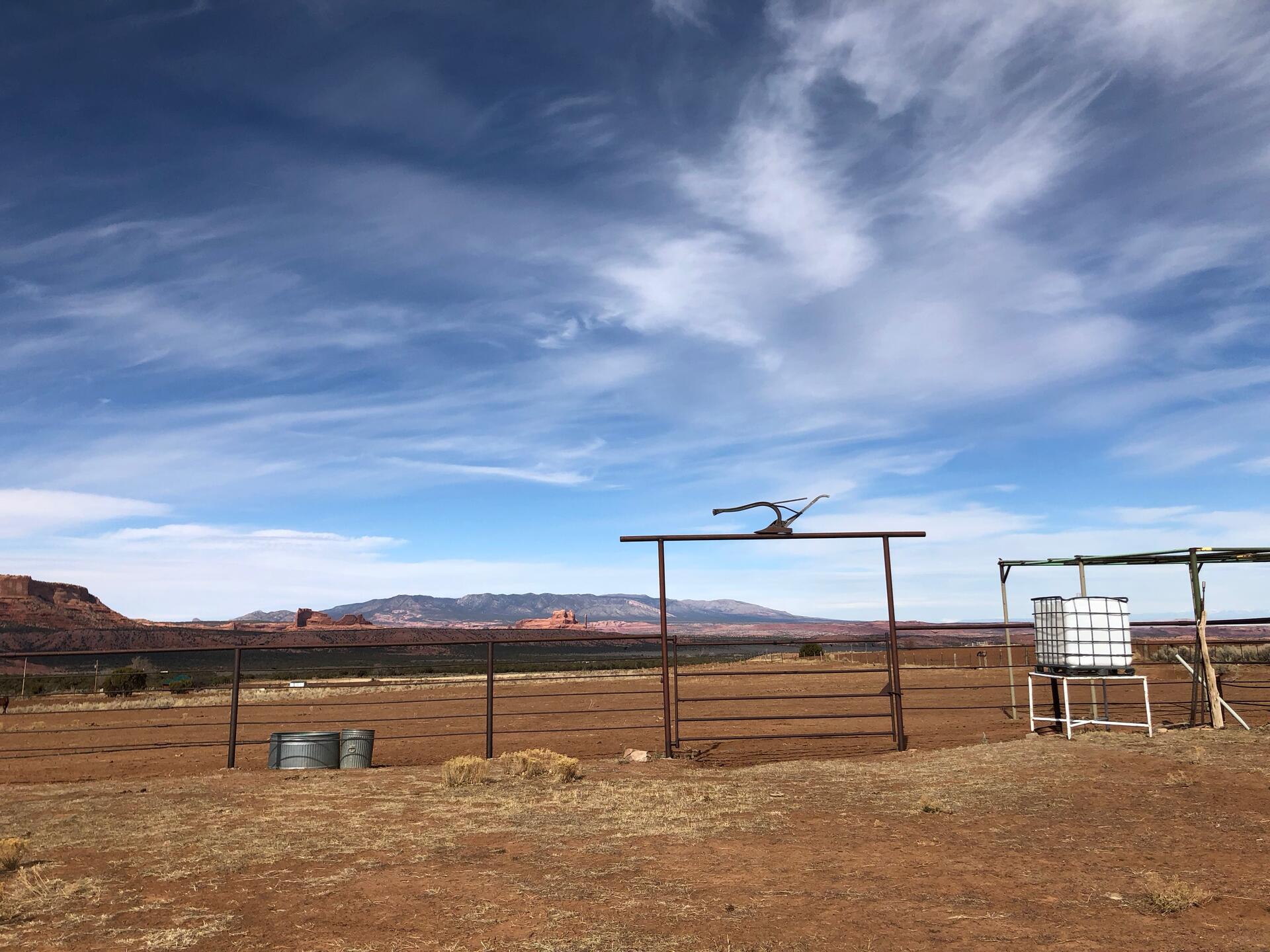
A farmstead near Cove, AZ.

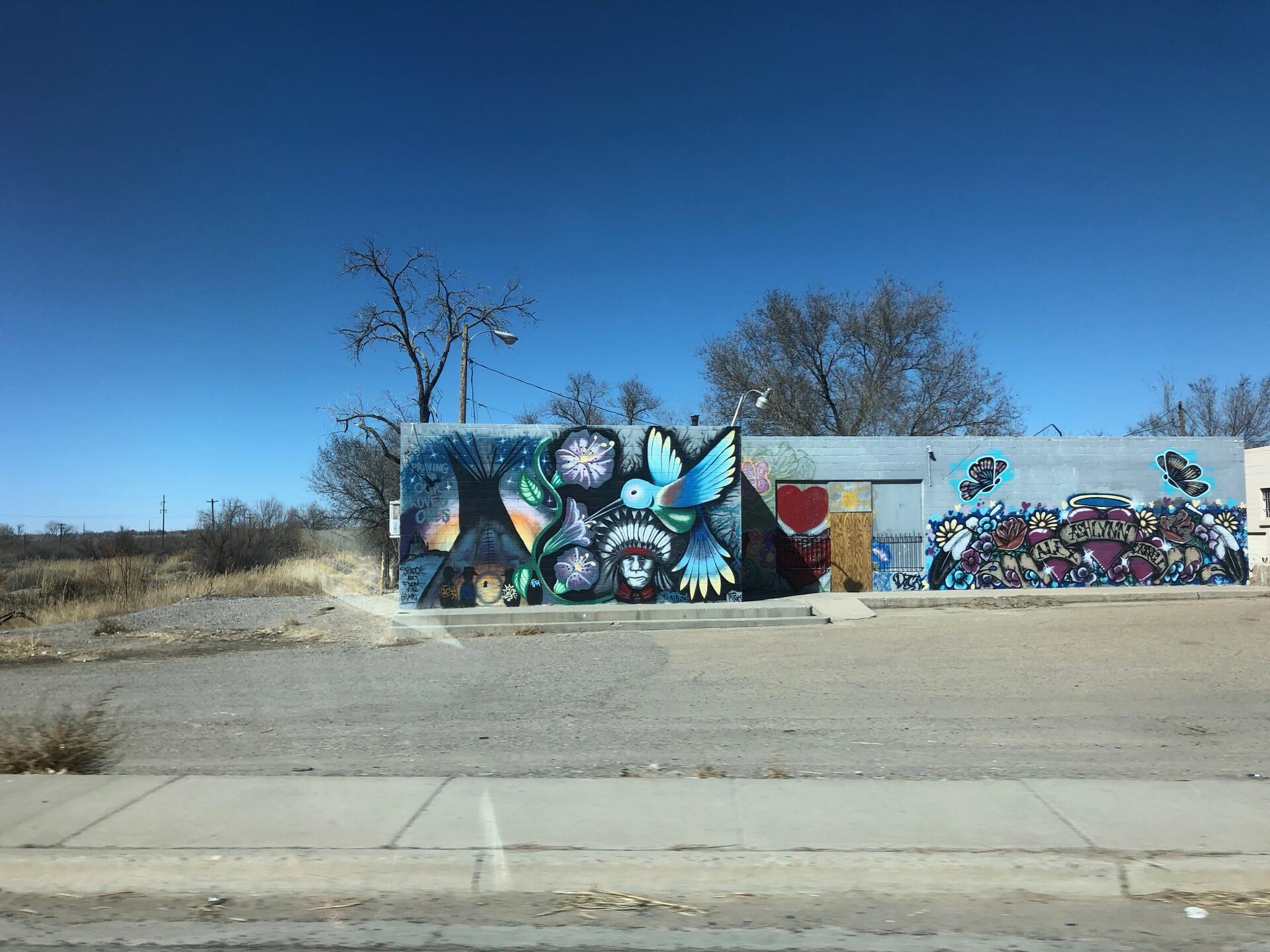
Murals on a building in Shiprock, NM.

Benally is alive today because he was a bit of a troublemaker. He had various jobs, but during his first stint as a uranium miner he agitated for a raise in their meager pay. He was subsequently sacked. Years later, in another employment in the mines, he approached the management about safety equipment and lost his job again. As Timothy said to me, “The reason I’m still alive today is that I was sacked twice. All the people I worked with are now dead.” It was a sobering, moving experience to listen to his narrative.
During the Cold War, the United States government’s development and deployment of powerful nuclear weapons demanded increasing quantities of uranium. The Navajo people were exploited and cheated out of huge tracts of land and employed on a fraction of the wages of the white Americans who supervised and profited from mine developments. They worked in terrible conditions, non-unionized and with little job security. Health studies testing for the effects of uranium dust on human bodies were undertaken on workers without their knowledge. Companies regularly changed hands and went out of business. A whole generation of Navajo men subsequently lost their lives to cancers and leukemias linked to uranium exposure.
Families used the fine dust tailings to plaster the inside of their homes, and as a result it was not only the men that died slow painful deaths, but women and children also developed related cancers and leukemias. After years of concerted pressure, the US government finally acknowledged its negligence. There are still shameful legacies of the exploitation of people and minerals in the landscape. In spite of their current obsolescence, and of large clean-up operations, spoilage from untreated abandoned mines still leaches uranium into rivers and farmland. It is shocking to realize that this happened to a whole group of people in a supposedly civilized, economically developed society within my lifetime. Sadly, this exemplar of governmental negligence and exploitation of an indigenous people is by no means an isolated incident.
Whilst the desert landscape of the Navajo nation still retains legacies of the scandal, it is actually very beautiful. There’s nothing obviously dangerous about being within it. Northern Arizona and New Mexico have stunning desert topographies. If you didn’t know that there had been a uranium mine at the top of a path, you wouldn’t think twice about it. But I actually picked up a piece of uranium ore on the road up to the Mesa No. 1 Mine in Cove, Arizona. I found it just lying on the road, yellow uranium ore. So, it is still in the landscape. And it’s when you talk to the people who live there that you understand that this toxic legacy is affecting lives even now, all these years later.
Of course, land and that sense of place is extremely important in Navajo culture. The question of just moving away because the land is polluted isn’t really something that most people can or will consider. The Navajo people are inextricably linked to their land and to sacred places within the landscape. I went to archeological sites with Karen and Timothy that go way, way back, with scatterings of pottery shards on the side of the road, that have been used for many, many hundreds of years. It’s important to be in that place. Where do you move to and what do you do? There’s a network of complex families and relationships within the Navajo nation.
It is shocking to realize that this happened to a whole group of people in a supposedly civilized, economically developed society within my lifetime.
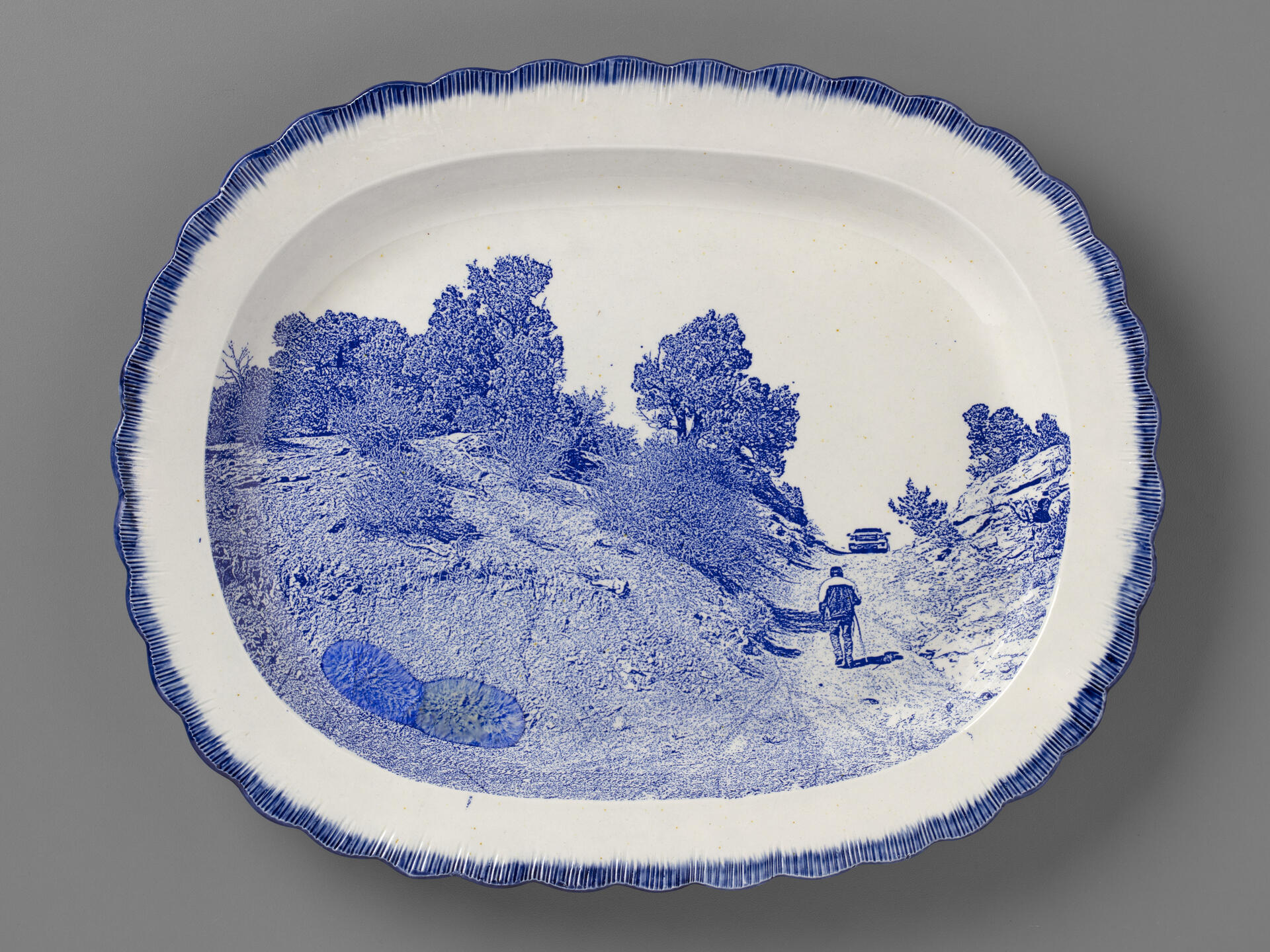
Paul Scott | The Uranium Series No 1 Mesa No: 1 Mine Road, Cove, Az., 2019 | Pearlware shell-edge platter (ca. 1840) with in-glaze screenprint decal and uranium glass
I made three artworks that relate to my experience in New Mexico and northern Arizona with Timothy. Uranium Series #1 and #2 are two shell-edge nineteenth-century pearlware platters. They’re landscape pieces. One of them depicts the road up to a uranium mine, the other a farmstead in Cove. They are beautiful, tranquil scenes, but I’ve melted uranium glass into their surfaces. Used for bombs and nuclear power stations, uranium also has a history as a colorant for glass and ceramics such as early Fiestaware. It was really fashionable at one time. Uranium glass is a sort of green-yellow, and under ultraviolet light glows luminous. You can buy this stuff on eBay and people collect it. I’ve used fragments of uranium glass, fired on top of the glazed print. The “beautiful” pictorial landscapes, like the real places they depict, also contain the deadly ore. (The minute quantities of fired uranium pigment in these objects do not pose any health risk, by the way.)

Paul Scott | The Uranium Series No. 2, Farmstead Cove Az., 2019 | Earthenware shell-edge platter (ca. 1840) with uranium glass
The third piece is A Souvenir of Shiprock. Shiprock is a town in New Mexico, just over the border from northern Arizona. It grew up around a trading post and is named after a dramatic rocky outcrop prominent in the landscape, a sacred place to the Navajo. The town subsequently became a center for uranium mining and other energy extraction. This new souvenir ware was created on a piece of blank Syracuse china salvaged from the abandoned pottery factory in upstate New York. The center vignette depicts the rock, and in one of the border cartouches Timothy Benally stands outside the Office of Navajo Uranium Workers. The uranium-mining compensation schemes were initially extremely complex and required huge amounts of documentary evidence in order for people to be eligible. The burden of evidence was on individuals who were victims of the careless mining. So often they were not able to fulfill onerous requirements to receive the compensation that they were due. It was an added insult to the Navajo. Benally proudly displays a sticker that says Cold War Patriot on the back of his truck. He also served with the Marines in Korea. These are people who gave significant parts of their lives in order to fight for the United States in foreign wars. The back of A Souvenir of Shiprock includes text that explains the significance of the uranium dumps in the town.
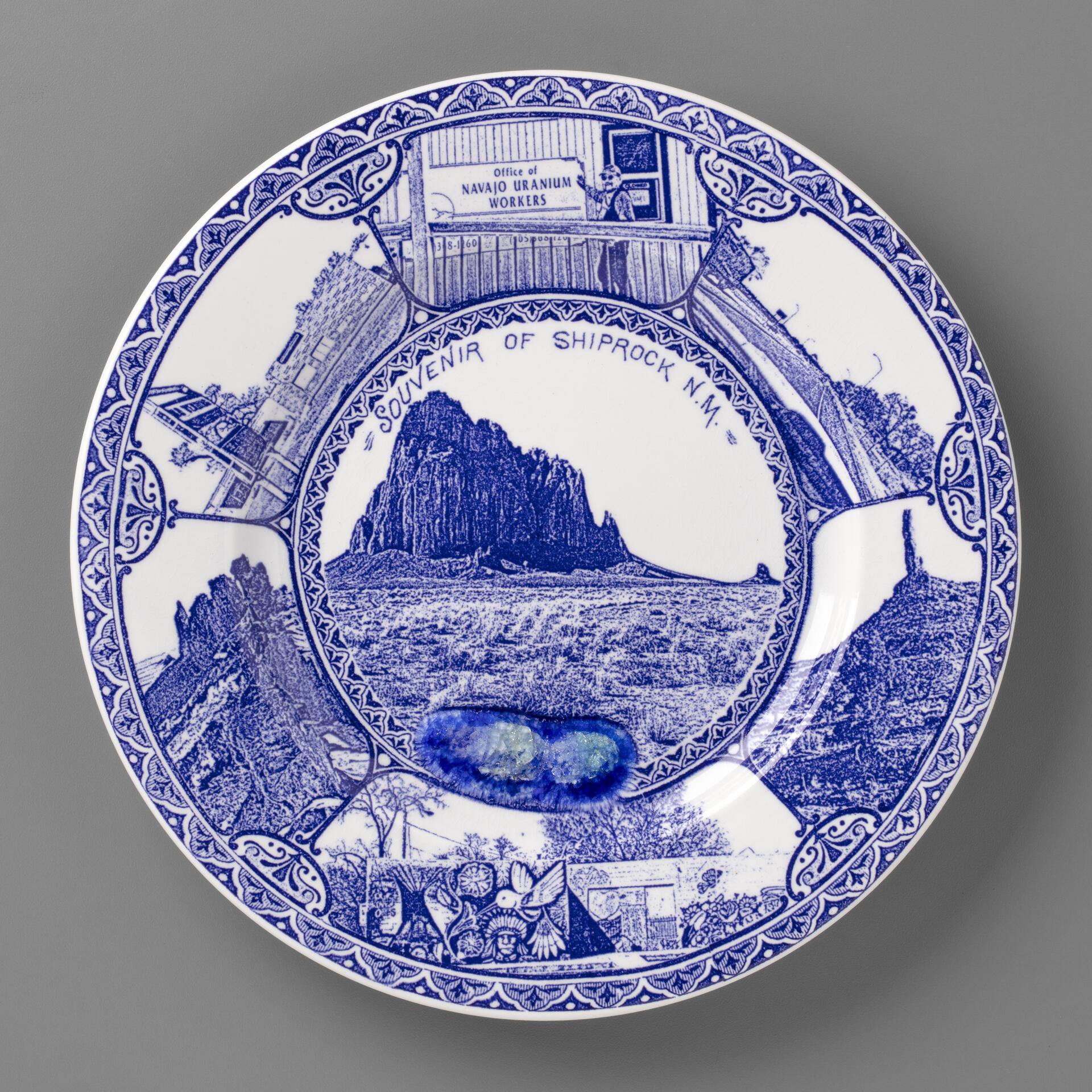
Paul Scott | Souvenir of Shiprock, 2019 | Salvaged Syracuse China with pearlware glaze, in-glaze screenprint decal, and uranium glass
I’ve chosen a number of objects from the RISD collection that reference Native Americans or American Indians, usually through the person of Roger Williams. What’s interesting is that all the depictions on transferware of meetings with American Indians, Native Americans, indigenous people, whatever you want to define them as, always appear to be between equals. Of course, we know from history that the relationship was far from equal. As a result of European settlement across the United States, indigenous peoples were either wiped out or moved to small, unproductive reservations. Ways of life and being were systematically destroyed.
There is of course no reference to this process in transferware. The depicted “noble” agreements were subsequently negated by the settler societies as they developed. Transferware depicts a sanitized version of history where there are no commemorations of massacres, but there are celebrations of battles won.
Transferware only tells one side of the story. My concern in creating the artwork for this exhibition was to try to balance things a little bit. I’m not pretending that in any way I can do that properly, but by highlighting the scandal of Navajo workers and uranium mining, I commemorate it and bring attention to a real, recent, shameful episode in US history.
One of the things you have to realize is that when originally made, transferware was a commercial product. It was made to sell to people, to make money. Of course, you wouldn’t have been able to make much money depicting massacres or scandals or ill treatment of fellow human beings—they wouldn’t have sold. But when I’m working on the transferwares, I’m not in a factory. I’m not looking to mass produce tens of thousands of plates. I’m making one, or very limited, numbers of artworks in a small series to tell particular stories. I’m an artist. I’m making transferwares in a completely different context, and I’m trying to update them for the twenty-first century as art, not as factory-produced multiples.

Josiah Wedgwood & Sons, manufacturer | Roger Williams Jug, 1886 | Transfer-printed earthenware | RISD Museum 16.127
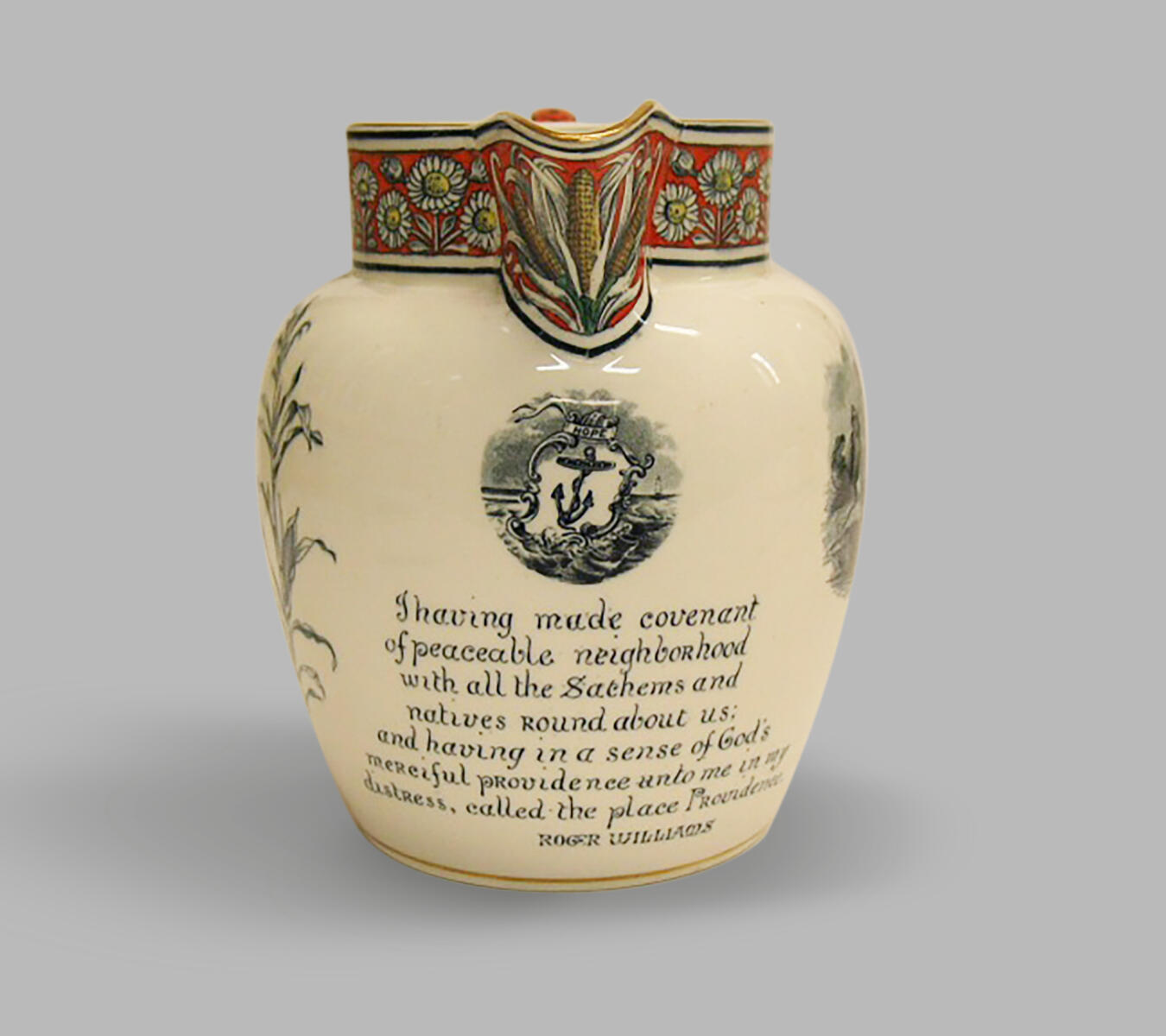
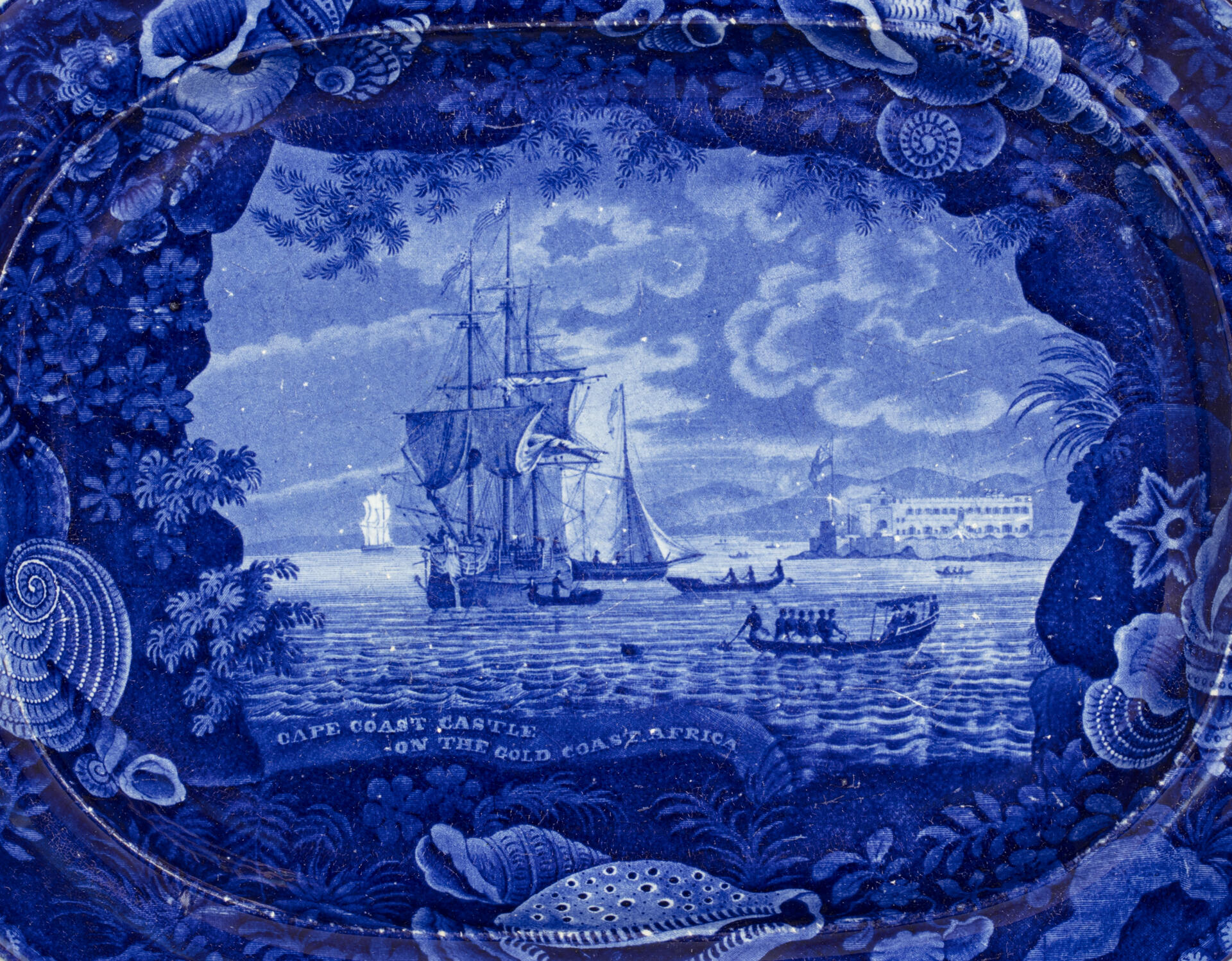
V
It’s a very odd feeling when you see something that is at first sight absolutely beautiful, but then you realize that the message, the imagery on the object, is so repugnant and so disturbing.
There’s this beautiful platter in the RISD collection. When I came across it I was taken aback. Like the platter I saw in my first encounter with the genre back in Columbus, Ohio, it has a shell decorative border, which indicates its maker as Enoch Wood & Sons. At first, I thought it was just another naval scene. Then as I looked closer and saw the title, Cape Coast Castle on the Gold Coast, I could see there were boats shipping people out to the large ship. They appear to contain African people. It dawned on me that this was probably a slaving ship, that enslaved people appeared to be heading for the vessel.
It’s a very odd feeling when you see something that is at first sight absolutely beautiful, but then you realize that the message, the imagery on the object, is so repugnant and so disturbing. I put it in my list of objects to work with or to look at, and it became more and more important over the last few years. As a result, I’ve made a number of pieces in response to that particular platter.
Cape Coast Castle became a trading post for human cargo. It’s a bit odd because in the early nineteenth century, Enoch Wood, the manufacturer of the platter in Staffordshire, apparently supported the abolitionist cause. He was amongst a group of relatively progressive owners of pottery factories looking to improve workers’ living conditions. So it’s a bit strange to discover that he was making platters depicting the slave trade that were clearly intended for the North American market; the ship has an American flag and as far as I’m aware the platter wasn’t available in Europe. Dr. Jo Dahn identified the original painting and print from which the platter was made. These appear to show a slaving ship, possibly British, off the Gold Coast. Whatever the nationality, there is the possibility that the scene depicted was after one of the abolition acts and that the ships involved were policing or enforcing the new law against slavery. Historically, there’s all kinds of interesting things going on here. But the main disturbance about the object is that it was sold, and presumably it was used. Maybe to present food. Maybe even presented by an enslaved person to those who were eating in a dining room. The whole thing was very disturbing.
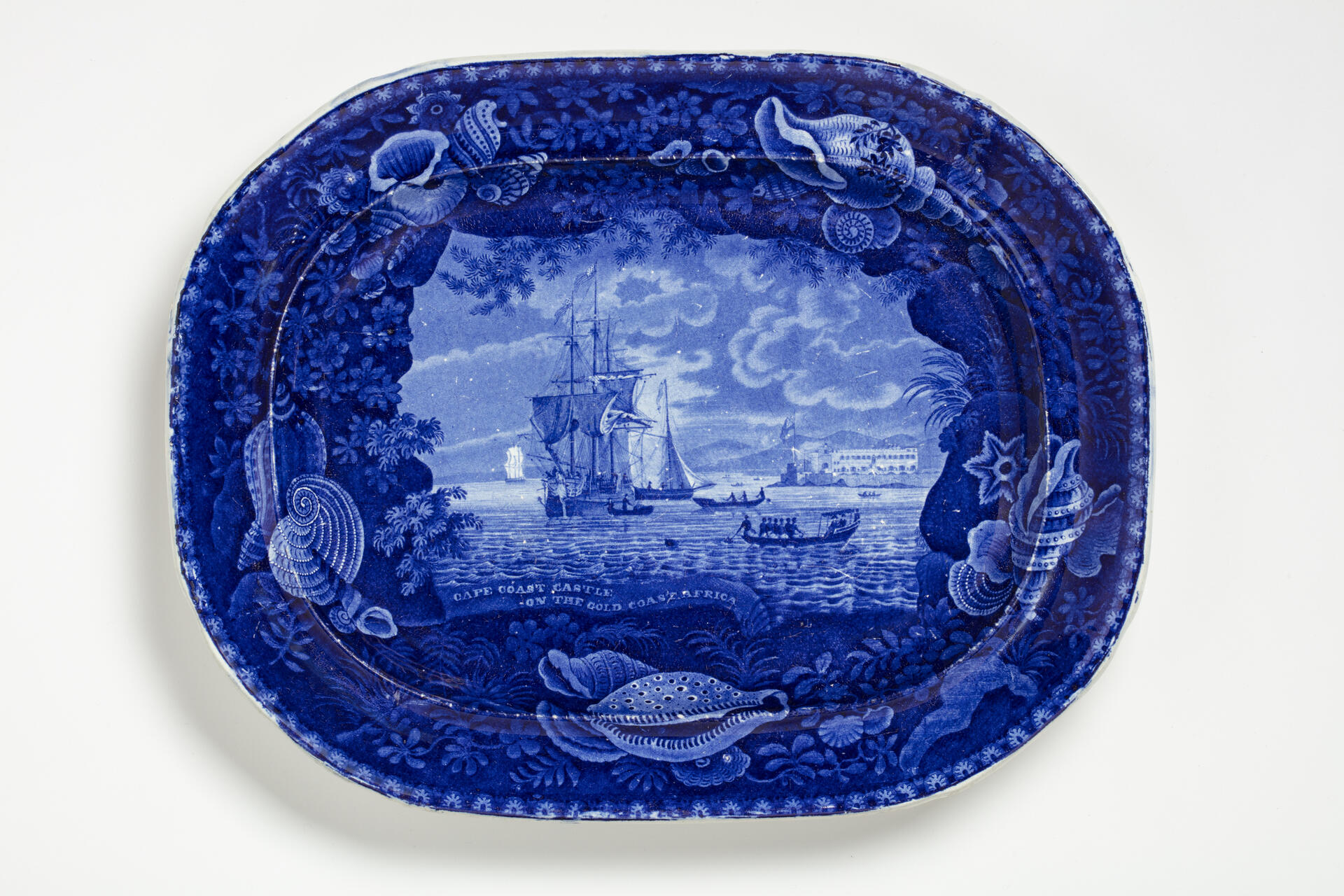
Enoch Wood & Sons, manufacturer | Cape Coast Castle on the Gold Coast Africa Platter, ca. 1840 | Transfer-printed earthenware | This plate belongs to Paul Scott. The RISD Museum has one in its collection as well.
I can’t guess what Enoch Wood or the people who were running his factory were thinking, but it’s clearly not a commissioned piece. It’s not the only Cape Coast platter. Brown University apparently has one on display, and I’ve actually acquired one from an antique dealer. This was a mass-produced object. As far as I’m aware, until Wedgwood’s abolitionist wares, Wood was the only supplier of images on platters that depict the slave trade. Enoch Wood & Sons’ wares were—and are—the consummate transferware objects. Their understanding of the interaction between engraved dot or line with ceramic pigment, glaze, firing, image, and pattern is unsurpassed in the history of the genre. It’s quite extraordinary. This platter was just one piece amongst many that they made for the North American market: the Hudson River; Lake George; Battery Park, New York—all kinds of landscapes.
It is hard to believe that they wouldn’t have understood what was happening in that image. What else would a ship be doing, moving off Cape Coast Castle in the 1830s? I suspect that later collectors will have understood that too, and that maybe in the twentieth century there was some discomfort about the depiction of the scene. Judging by auction records of prices paid for recent sales, it is still clearly a desirable piece. It refers to a dark but key part of American history.
There is a general whitewashing of matters to do with enslavement and slavery within American (and British) culture. Only this morning I read an article about plantation tours of houses in the South. Basically, most plantations don’t describe the conditions of enslaved people and don’t deal with the issue.
It’s interesting that in Providence, both Brown University and RISD have these platters. Stanley Lemon’s article “Rhode Island and the Slave Trade” [Rhode Island's History 60, no. 4], published by the Rhode Island Historical Society in 2002, sheds a clear light on the matter: “The American Slave Trade from 1727 to 1807 might better be called the Rhode Island slave trade. Throughout the eighteenth century, Rhode Island merchants controlled between 60% and 90% of the American trade in African slaves.”
Whilst slavery was ostensibly abolished by the middle of the nineteenth century, African Americans were not given the tools or means to become full citizens of the United States. That situation has persisted. Civil rights marches in the 1960s when Americans started rebelling en masse against discriminatory laws were met—as they have always been—with belligerence and violence.
One of the catalytic moments for the civil rights movement occurred during a march over the Edmund Pettus Bridge in Selma in 1965. Peaceful civil rights marchers (including young children) attempted to walk across the bridge and were met by extreme violence from Alabama state troopers and the sheriff. State violence was by no means uncommon, but this time the national press got wind of it, with the result that it became headline news not only across American televisions and newspapers but also across the world.
The Pettus Bridge is an iconic structure, certainly for those people who believe in democracy for all American citizens regardless of their race or creed or color. I was able, by remarkable coincidence, able to time my visit to Selma to coincide with the anniversary march in 2018, so I became part of that event which was a moving and positive occasion.
I also went to visit one of the plantation houses in the town, which is a beautiful building with hand-painted and printed wallpapers, elegant furniture, and all the rest of it. But I was profoundly disturbed to discover that on the tour around the house, there was no mention whatsoever about the black Americans who had created the wealth for the family who had built it and lived there. There were no pictures or evidence of them. There was no reference to slavery at all.
Marching across the Edmund Pettus Bridge in 2018, commemorating a peaceful civil rights march in 1965 that was interrupted by police brutality.

A hand-painted sign in Selma, AL.

Another view of the Edmund Pettus Bridge in Selma, AL. The bridge is named for a Confederate general.

Sturdivant Hall, a Selma mansion built in the 1850s.

Of course, as I said before, the only African Americans depicted in early transferwares were enslaved people. In the early twentieth century, again, Black Americans are noticeably absent from the souvenir wares produced by Wedgwood, Rowland & Marcellus and other factories. Like the plantation houses, they don’t appear to have a place within the version of history served up on ceramic plates. So I decided that I should balance it, you know, just a little bit. As an artist, I’m a small cog, but I wanted to make pieces that referenced the ongoing legacies of slavery and racism.
A Souvenir of Selma is based on a Rowland & Marcellus design, A Souvenir of Jackson, Mississippi. The original plate includes a Confederate monument in the border and I thought it eminently suitable for appropriation. I’ve removed the original pattern contents then inserted a view of the 2018 anniversary march as the central vignette. There are assorted scenes of contemporary Selma around the border. This is however a very bittersweet souvenir. Text is a common feature on twentieth-century souvenir plates, so on the back of A Souvenir of Selma, I’ve qualified the commemorative scenes with a quote from an article by photographer and author Chris Arnade for the Guardian newspaper in February 2016. In recent years Arnade has been chronicling the lives of people living in deindustrialized and impoverished communities across the United States. In “Selma, Still a City of Slaves” he writes:
The central street beyond the bridge is three short blocks filled with shops catering to tourists. Yet if you walk beyond those blocks you see the ugliness of poverty that is modern Selma: dilapidated and boarded-up homes tagged with gang symbols, empty lots littered with vodka bottles and fast-food wrappers, and sterile low-income projects. You see men clustered on corners selling drugs, and on the better-kept homes you see sign after sign urging, ”Stop the violence.” You don’t see working factories, only empty ones being torn down for scrap. You see a population disenfranchised, economically and politically. It makes Selma, a symbol of past civil rights victories, a symbol of current civil rights failures.
On salvaging bricks from an old cotton warehouse, a local worker mused, ”This is slave work, that’s what it is, but the only work around. Kind of funny when you think about it, because them bricks were probably made by slaves. That is Selma for you, though: still a city of slaves.” Later in the article, another resident says that “special things DID happen here. Just wish they would happen again.”
There's a lovely piece of transferware in the RISD collection which depicts the Philadelphia Water Works. Entitled Fairmount Near Philadelphia, and made by Joseph Stubbs in the early nineteenth century, it’s one of those typical pieces about civic projects done for the benefit of society. The Philadelphia Water Works supplied clean water to the city. In contrast, there's Flint.

Paul Scott | Souvenir of Selma, 2019 | Salvaged Syracuse China plate with pearlware glaze and in-glaze screenprint decal
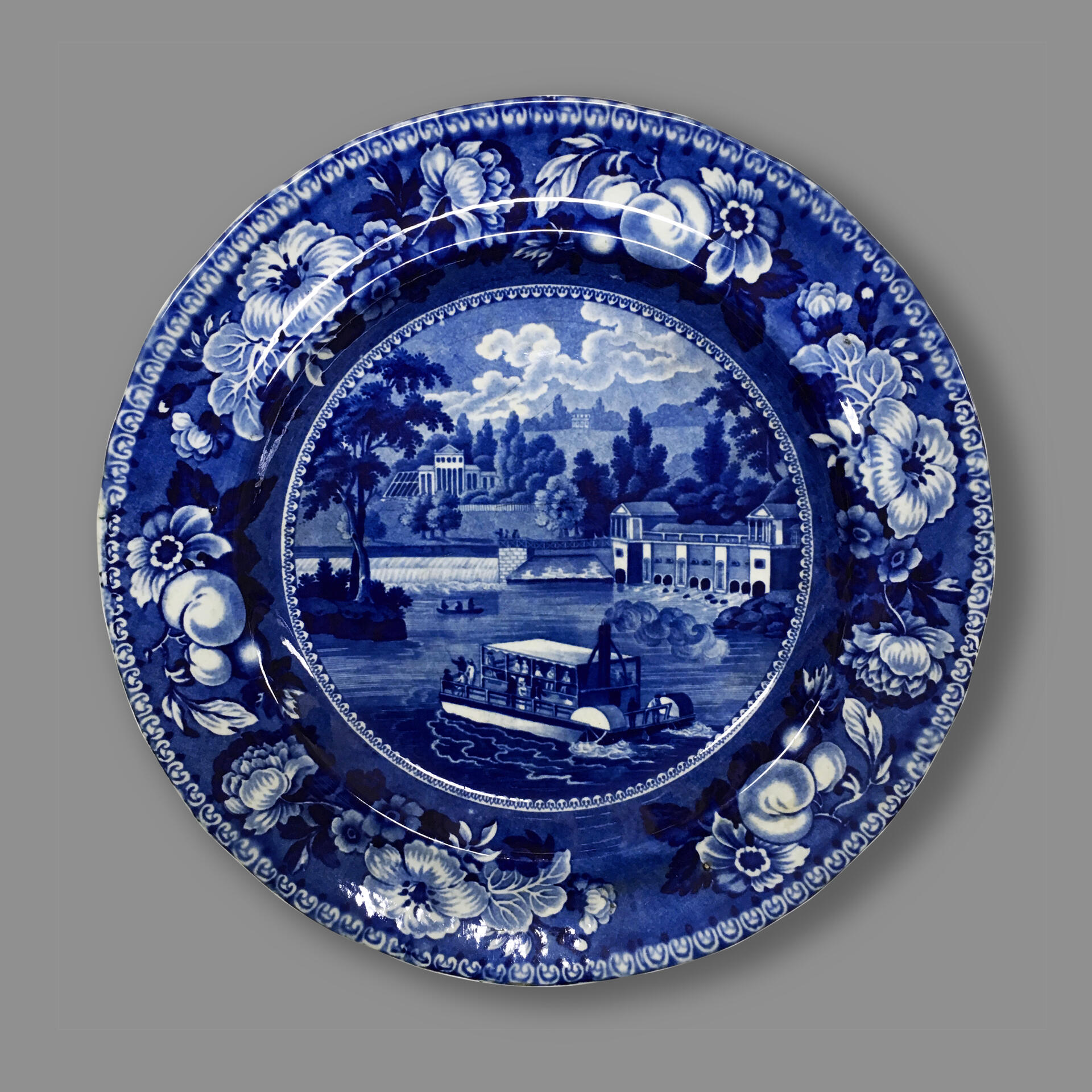
English | The Dam and Water Works Plate, ca. 1835 | Transfer-printed earthenware | RISD Museum 35.091
In 2014, the authorities in Flint, Michigan, switched its drinking-water supply from Detroit’s system to the Flint River in a cost-saving move. Inadequate treatment and testing of the water resulted in a series of major water quality and health issues for Flint residents—issues that were chronically ignored, overlooked, and discounted by government officials even as complaints mounted that the foul-smelling, discolored, and off-tasting water piped into homes for months was causing skin rashes, hair loss, and itchy skin. The Michigan Civil Rights Commission, a state-established body, concluded that the poor governmental response to the Flint crisis was a “result of systemic racism.” Later studies would reveal that the contaminated water was also contributing to a doubling—and in some cases, tripling—of the blood lead levels in the city’s children.
It seemed appropriate to me to make a new piece to sit alongside the nineteenth-century Stubbs plate. Flint Near Detroit depicts the Flint Water Works, within a border pattern created from an original tissue-transfer found in the V&A archive. Melted into the glazed surface of the plate is a small lump of lead; at its center the metal has burnt completely through the glaze and created a watery pool over the foreground around it.
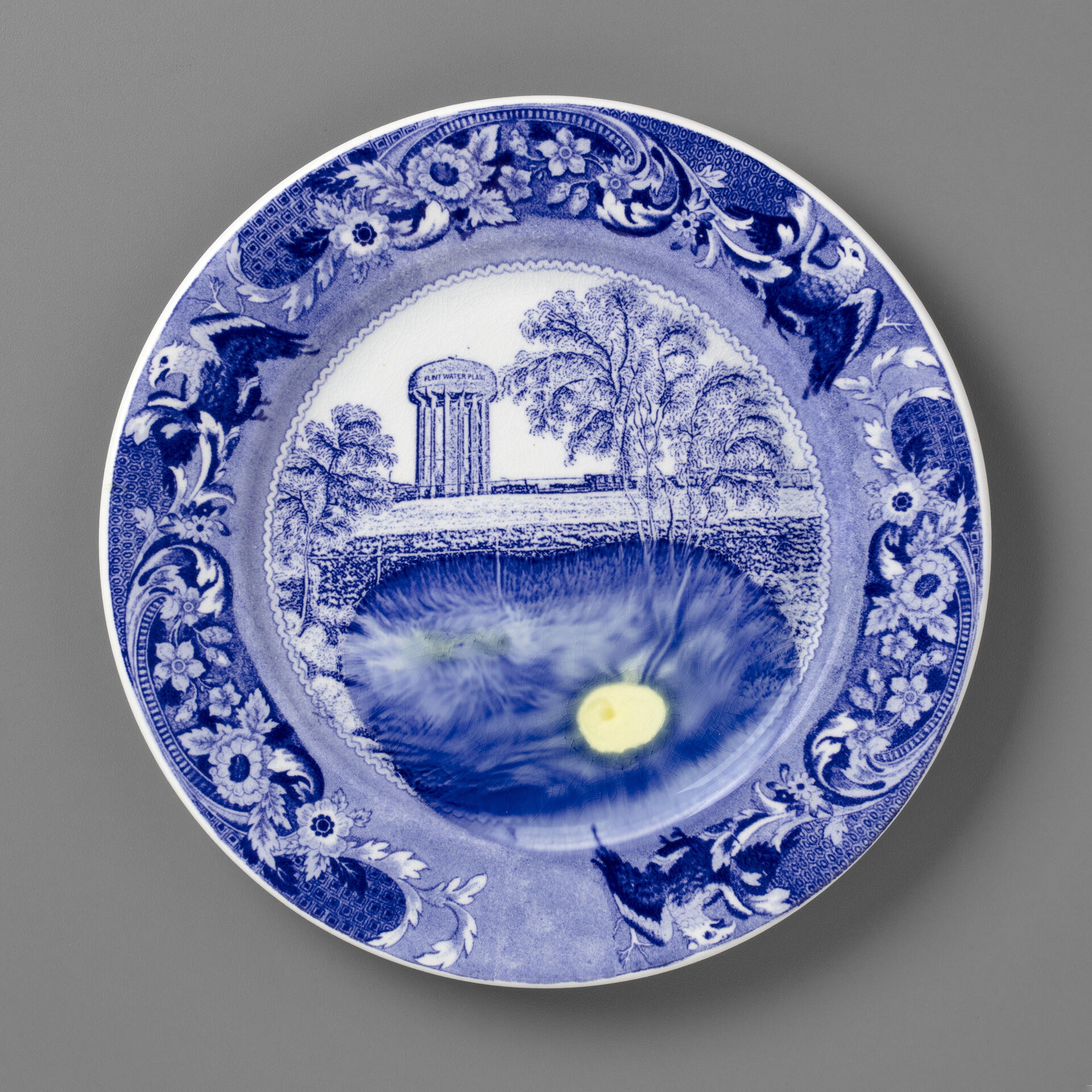
Paul Scott | Flint, near Detroit, 2019 | Salvaged Syracuse China plate with pearlware glaze, in-glaze screenprint decal, and melted lead
In the early nineteenth century a number of transferware designs featured of plates with cartouches of portraits in their borders. These figures included Washington, Dewitt, Clinton, people involved in the Erie Canal, presidents and people like that. I thought this an appropriate device to update.
Because of the work of a friend and fellow artist, Carrie Reichardt, I have long been aware of the campaign to free three African American men, members of the Black Panther party, who were held for decades in solitary confinement while imprisoned at Louisiana State Penitentiary. Wrongly incarcerated for the murder of a prison guard, they were convicted by an all-white jury through fabricated evidence and false testimony. The campaign to free them went on for many years. I have made a plate featuring the Angola Three above a scene of the entrance to the Louisiana State Penitentiary. Another work, Peltier and Pipelines, features the incarcerated American Indian Leonard Peltier, who was wrongly convicted of the murder of an FBI agent.
As a white English artist, I don’t purport to represent the experience of Black or Native Americans, because I can’t in any way do that. But what I can do is to rebalance transferware’s whitewashing of subject matters and depictions so that they are more reflective of contemporary American landscape and society.
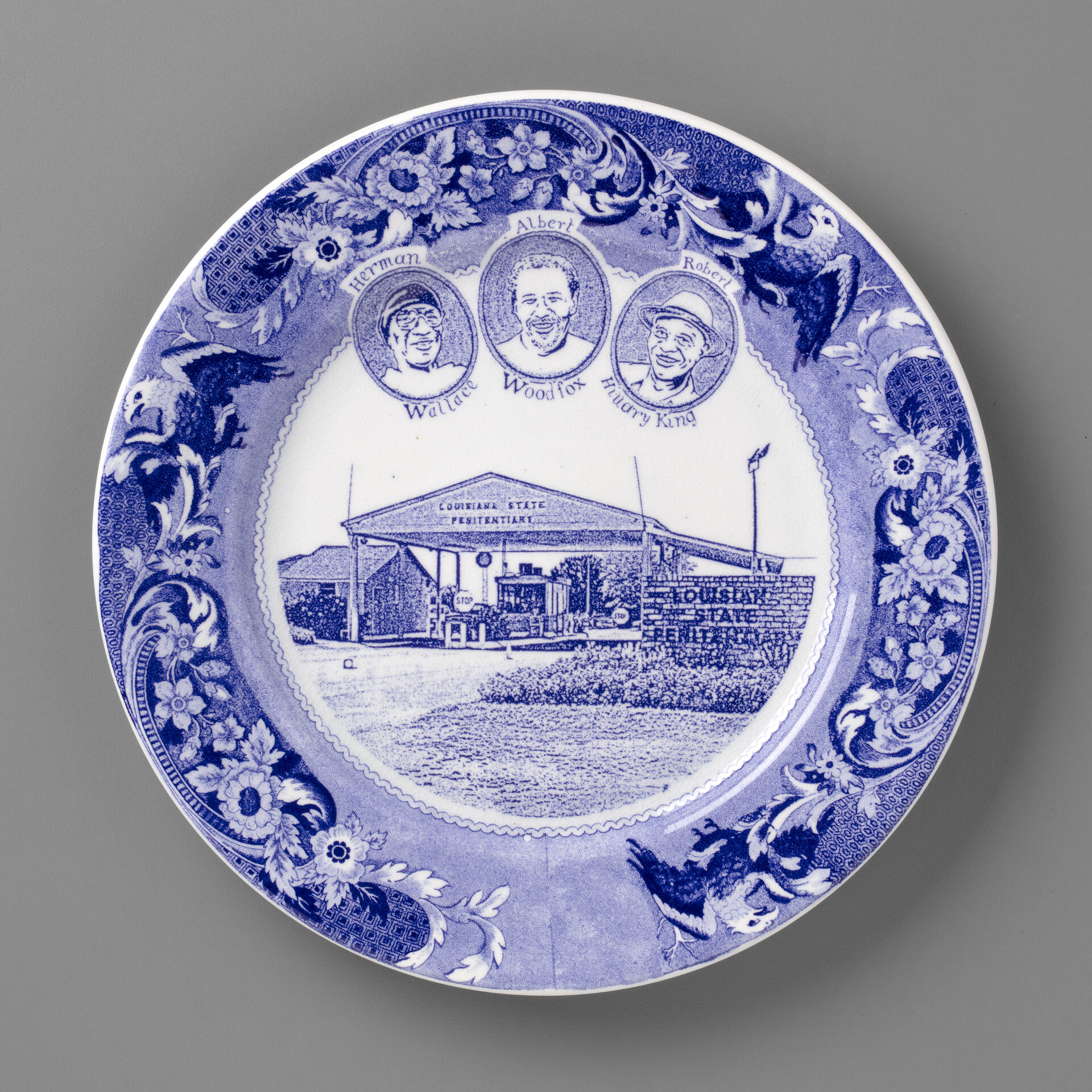
Paul Scott | Angola 3, 2019 | Salvaged Syracuse China with pearlware glaze and in-glaze screenprint decal
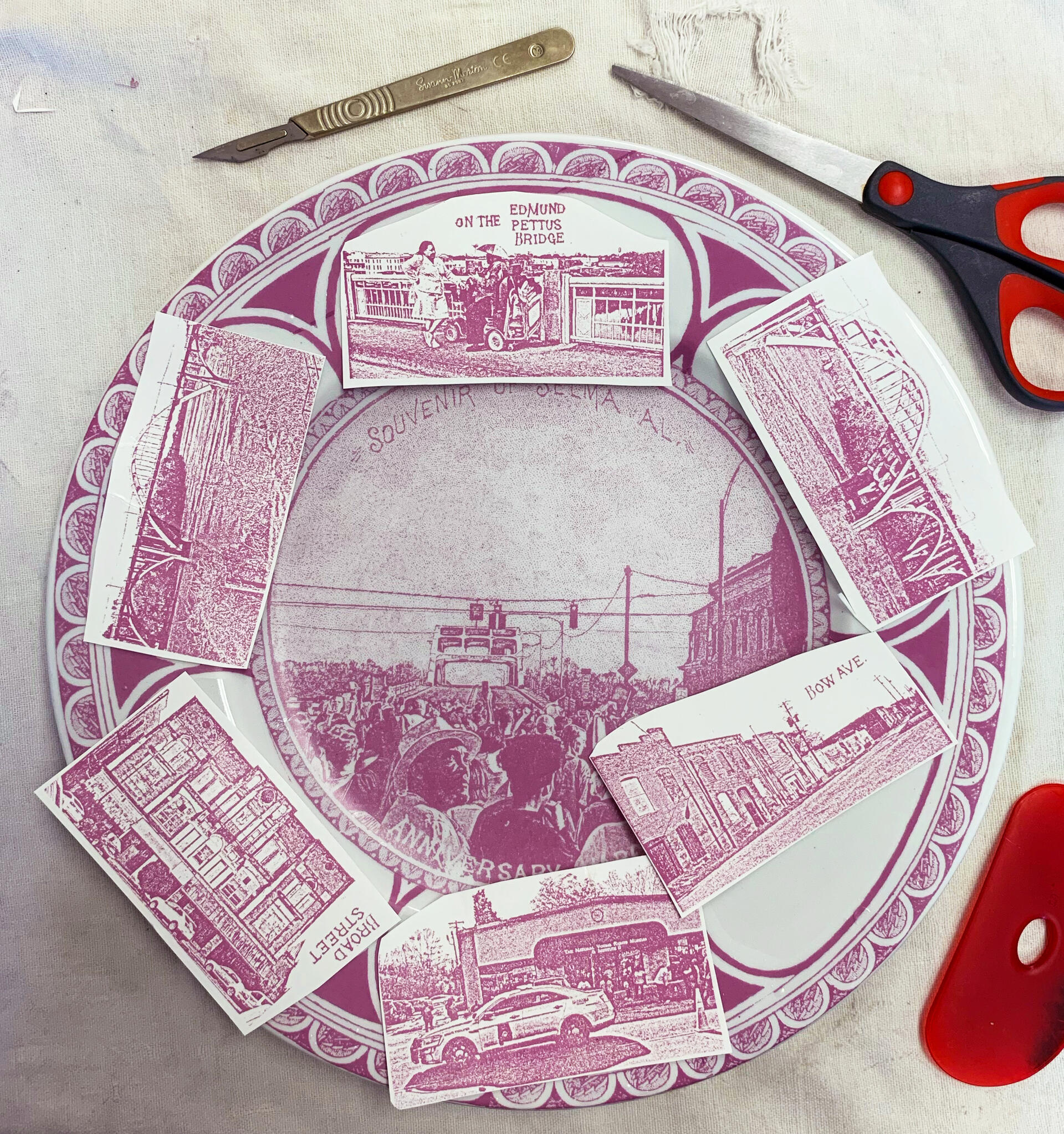
VI
Of course, when I make my work, whether it is about the landscape of Britain or the United States, I make it from my particular perspective. I have deep concerns about the ongoing degradation of our ecosystems and about the ways in which our shared histories are articulated, refined, and distorted in the re-telling. My artworks inevitably reflect these personal perspectives, but they also celebrate a rich and complex historical genre. I trust that New American Scenery enables people to see transferwares in a new light.
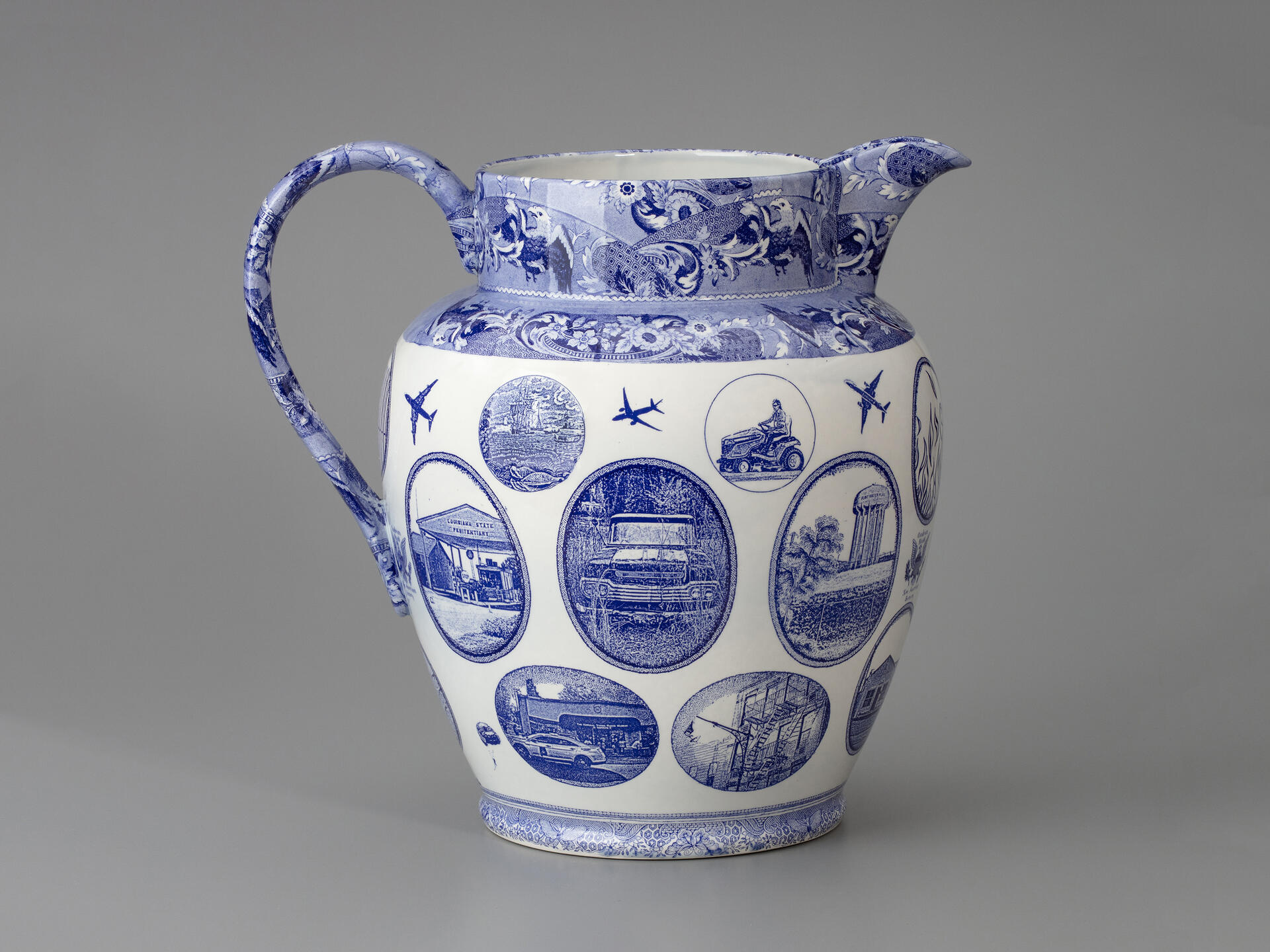
Paul Scott, designer & Ed Bentley, designer and modeler, Ceramics by Design, fabricator | Sampler Jug No: 2, Big Bend & Hot Dogs, 2019 | Earthenware with pearlware glaze
***
Cite this article as
Chicago Style
MLA Style
Shareable Link
Copy this page's URL to your clipboard.
Created under the direction of Paul Scott, this chapter accompanies the exhibition Raid the Icebox Now with Paul Scott: New American Scenery, on view at the RISD Museum September 13, 2019–September 6, 2020. Creative direction for this chapter by Carson Evans. Curatorial support by Elizabeth A. Williams. Additional support by Jeremy Radtke.
Paul Scott would like to thank Lesley Baker, Karen and Timothy Benally, Ed Bentley, Mary Jo Bole, Larry Bush, Garth Clarke, Howard Coutts, Jo Dahn, Jeremiah Day, Rachael Delphia, Leslie Ferrin, Jon Goodman, Paul Holdway, Candace and Michael Humphreys, Beth Katleman, Les and Jaye Lawrence, Lucy Lead, Akemi May, Douglas McCombs, Leah Mitch, John Polak, Project Art, Andrew Raftery, Scott Rench, Anne Renwick, Shax Riegler, Ted Rowland, Mara Superior, Olivia Horsfall Turner, Mara Superior, and Mark de Vecchio.
Museum object photography by Erik Gould.
Paul Scott object photography © John Polak.
All other photography © Paul Scott.
